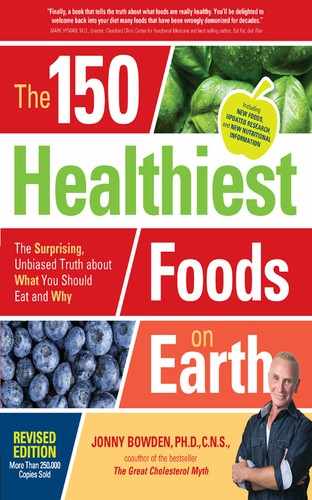
Let’s get one thing straight right away: There are no bad vegetables. Maybe I need to clarify just a bit, because the most consumed “vegetables” in the United States include ketchup, iceberg lettuce, and french fries. I’m talking about anything that has a leaf. I’m talking about anything that makes a crunch when you bite it. I’m talking about anything that’s green, red, orange, or, in rare cases, white (cauliflower and mushrooms). Get the point? I’m not talking about french fries.
So, if the title of this book were The 500 Healthiest Foods on Earth instead of the 150 healthiest foods, probably every member of the vegetable family you can possibly think of would be listed—which is not the case with dairy, grains, or some other categories in this book. Even corn and potatoes make the cut. (And they wound up on no one’s top ten list, I’m happy to say.) The thirty-six vegetables that made the A-list here are those that I felt represented the absolute best nutritional bang for the buck in a crowded field in which most entries are already winners.
Aren’t Some Vegetables Fattening?
We’re currently experiencing an obesity and diabetes epidemic in most of the Western world (and even in some parts of the non-Western world), and a reasonable question to ask would be this: Are some vegetables more fattening than others, and should they be avoided?
Generally speaking, the answer is no.
There’s a lot of confusion about certain starchy vegetables that have a high glycemic index, vegetables that people following lower-carb eating plans have been told to avoid. The short answer is this: If you’re a person for whom blood sugar management is a real issue, yes, some vegetables on this list—sweet potatoes, for example—might be worth limiting. But, in my opinion, the argument about vegetables and sugar is a tempest in a teapot.
There are two real culprits in the obesity crisis: one, the fast-acting carbs and sugars in breads, cereals, pastas, desserts, cakes, rolls, crackers, and fast food; and two, the obscenely large portions of everything else. As my wisecracking pal, the brilliant nutritionist and U.S. Department of Agriculture (USDA) researcher C. Leigh Broadhurst, Ph.D., says, “No one ever got fat on peas and carrots.”
So of course, watch your sugar content. But most vegetables don’t have that much, particularly compared to the real culprits in the American diet. (Potatoes and corn are exceptions.) You can’t go wrong with a single vegetable on this list, and you would do well to consume a variety of all of them.
So here’s my list of top winners in the vegetable sweepstakes. Argue with them, if you like. Add some favorites of your own, and throw out a couple you really hate. Just eat as many as you can.
You’ll be giving yourself a real gift of health.
 The Stars
The Stars
It was difficult deciding which foods to give a star to, and I’m sure you could argue that some good foods didn’t get stars. You’d be right. Remember, everything on this list is already a star in its respective category. For example, in this chapter I gave stars to the superstars—the vegetables that are so uniquely loaded with nutrients, fiber, cancer-fighting phytochemicals, or some combination thereof, that they deserved some special mention, even among the company of great foods.
Artichokes

Artichokes are kind of like the lobster of the vegetable community—you must really work to get at the good parts. The part that contains the meat is called the heart, even though it’s technically the bottom of the plant. And it takes some digging to get there. Is it worth it? Definitely.
Artichokes are a liver-cleansing food. If you’ve ever looked at the ingredients on a supplement specifically designed for liver health or for detoxification, you’re likely to have seen artichoke extract listed on the label. Why? Because this plant is a wonderful source of silymarin, the active ingredient in milk thistle. Silymarin has a long and distinguished pedigree as a plant compound that helps protect and nourish the liver. And artichokes have plenty of it.
Artichokes Bring Stomach Relief
That’s not all they have. The artichoke leaves contain several active chemical compounds that have been found to be beneficial across a range of health issues. For example, the bile-stimulating action of the plant has been well documented in at least one controlled trial in which, after administration of artichoke extract directly into the duodenum, liver bile increased significantly. This may be why artichokes are often used for indigestion. According to herbal experts Joe and Teresa Graedon, Ph.D. (authors of The People’s Pharmacy), patients with chronic gastrointestinal (GI) upset who were given artichoke extract showed amazing improvement. In one study, researchers reported that 85 percent of patients experienced substantial relief from stomach pain, nausea, and vomiting.
The standardized extract has also been used to treat high cholesterol and triglycerides, and in test-tube studies, the flavonoids from the artichoke (especially luteolin) have prevented the oxidation of LDL (“bad”) cholesterol, a definite risk factor for cardiovascular disease.
Although artichoke extract has a distinguished history as an herbal supplement, the vegetable itself is a healthy food. It contains 72 mg of magnesium, 425 mg of potassium, a little folate, the eye-friendly carotenoids lutein and zeaxanthin, and best of all, a substantial 61/2 g of fiber per one medium artichoke. (If you go for a large one, you get almost 9 g of fiber!) And that’s all for a miserly 60 calories. (Okay, 76 if you’re going for the big guy.) A good nutritional deal no matter how you slice it. Or, in the case of the artichoke, how you dig for it.
Arugula
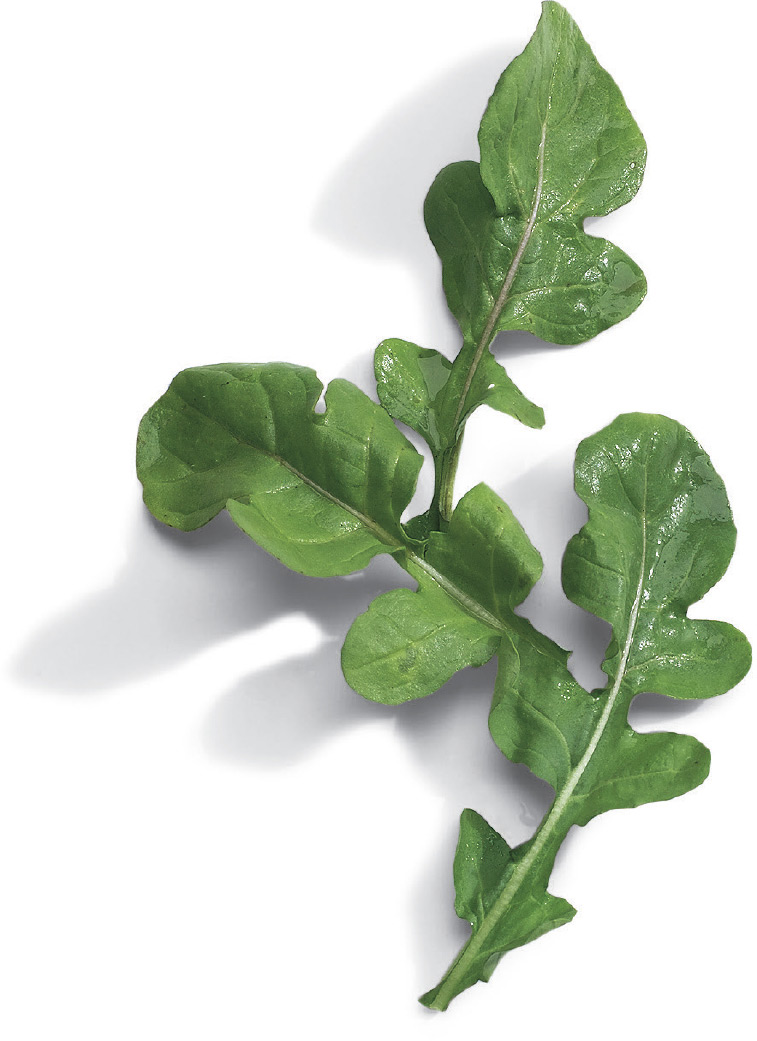
Arugula sure doesn’t look like an aphrodisiac, but that’s exactly what the ancient Egyptians and Romans considered it to be. I don’t know about that, but I do know that it’s the überfood of nutritional bargains: One cup (20 g) of arugula contains… get ready… 5 calories. For that you get some folate (folic acid), vitamin A, and a surprisingly decent amount of the extremely eye-healthy carotenoids, lutein, and zeaxanthin.
There’s also about the same amount of calcium as there is in spinach, but arugula is actually lower in oxalates, a substance that inhibits calcium absorption.
Arugula has a nice amount of vitamin K: One cup (20 g) contains almost half the recommended daily allowance (which in my opinion is too low). Vitamin K is essential for clotting and is a key player in developing strong bones. The Framingham Heart Study, for example, found that people who consumed approximately 250 mcg of vitamin K a day had a 35 percent lower risk of hip fractures compared to those who consumed just 50 mcg a day. True, you’d have to consume 10 cups (200 g) of arugula to get that much, but still, a few cups (33 mg) in a salad is a good start.
The arugula plant, like many others in the cruciferous family, contains glucosinolates. When you chew the plant, the glucosinolates mix with an enzyme (myrosinase) that turns them into other compounds called isothiocyanates, which have documented anticancer properties. Isothiocyanates combat carcinogens by neutralizing them, reducing their poisonous effect, and stimulating the release of other substances that help combat them. Isothiocyanates also inhibit cell proliferation. Studies have shown that they help prevent lung and esophageal cancer and can lower the risk of other types of cancers, including gastrointestinal cancer.
That’s an awful lot of good stuff to pack into a cup of food that contains only 5 calories.
Asparagus
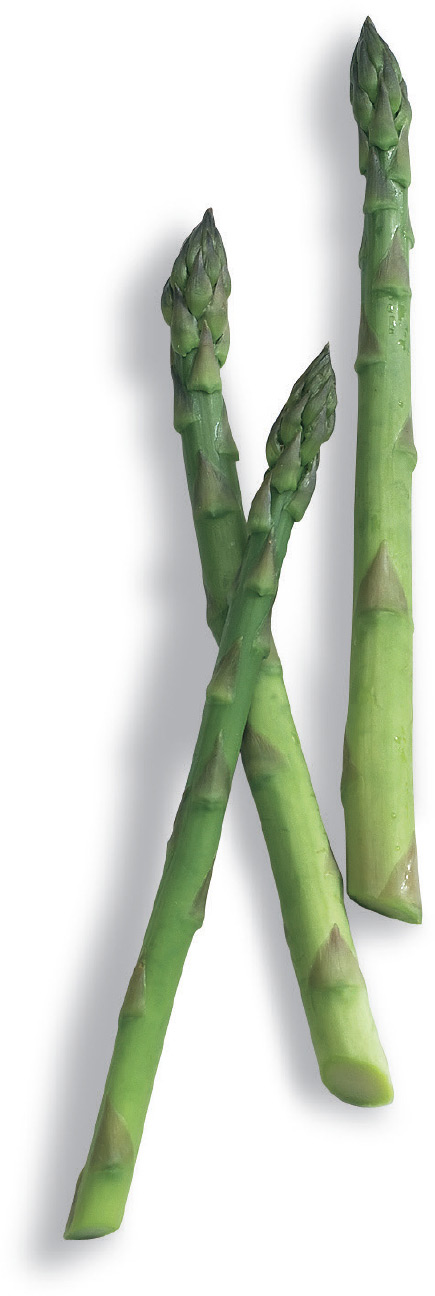
Here’s an interesting piece of trivia about asparagus: They’re one of the only plants that have distinct male and female versions. And if you’d like a dollop of irony with that factoid, the male plants are skinny and the females are… well, Rubenesque. To compound the political incorrectness, it’s the fresh young plants that are the most desirable—they taste the best. On the other hand, when allowed to mature, a gorgeous fern develops. You can’t eat it, but it makes one of the most beautiful hanging plants around.
The asparagus has two parts—a thick root and the tender stalks. The root is used in traditional Indian medicine as a diuretic and to strengthen the female reproductive system. The asparagus root is also believed to help develop peace of mind, a loving nature, a good memory, and a calm spirit. Chinese traditionalists save the best roots of the plant for their families and friends, believing that it will increase feelings of compassion and love. Meanwhile, in India, it’s used to promote fertility, reduce menstrual cramping, and increase milk production in nursing mothers. These customs have some basis in science—the root contains steroidal glycosides that affect hormone production and possibly influence emotions. In India, the racemosa species is used to increase sperm count and nourish the ovum.
In the Western world, asparagus has long been touted as an aphrodisiac. I was unable to find any scientific evidence for its ability to make people amorous, but the legend remains, probably due to the vegetable’s phallic shape. It’s worth noting that asparagus is also known in India by the name Shatavari, which means “she who possesses 100 husbands.” Draw your own conclusions.
Low in Calories, High in Nutrients
Asparagus, like most fruits and vegetables, has a favorable ratio of potassium to sodium. A cup (180 g) of cooked asparagus contains a whopping 404 mg of potassium, as well as 268 mcg of folate, an important B vitamin that helps prevent neural tube defects and helps reduce a harmful blood chemical called homocysteine. It’s also high in vitamin K, essential for healthy clotting and for strong bones. There’s also rutin, which helps protect blood vessels, and the anti-inflammatory, cancer-fighting flavonoid quercetin. And finally, a cup (180 g) of cooked asparagus gives you a decent 4 g of fiber, all for a ridiculously low number of calories (40).
Best of all, there’s serious published research showing that compounds in asparagus have antitumor activity. A study from Rutgers University, published in Cancer Letters, showed that crude saponins from asparagus inhibited the growth of human leukemia cells. Asparagus is also high in glutathione, one of the body’s most important antioxidants. And asparagus contain inulin, a special kind of fiber that feeds the good bacteria in your gut and helps support gastrointestinal health.
The only downside to asparagus is that it makes your pee smell funny. This is because it contains the amino acid asparagine. It’s weird and annoying, but completely harmless.
 Beets
Beets

Since the original edition of this book, beets have attained something of a superstar status in the nutrition world, particularly among athletes. Beets are rich with nitrates, which metabolize into an important (and desirable!) molecule called nitric oxide. Beets have become extremely popular with cutting-edge nutrition buffs largely because of growing appreciation for the importance of nitric oxide, which relaxes the arteries, lowers blood pressure, and may increase circulation to exercising muscles. Athletes now take beetroot juice supplements in the hope that the nitric oxide they produce will help their energy and performance.
In many holistic, integrative, and Eastern traditions, beets are believed to be an excellent liver tonic and blood purifier. They’re a staple of the juicing crowd, for good reason (more in a moment). Beets get their red color from a compound in them called betacyanin, which is the messy stuff that stains your clothes and hands. Betacyanin also turns your urine red, so if you juice with beets, don’t be alarmed—you’re not bleeding internally!
The Heart-Healthy Benefits of Beets
Beets are an important dietary source of betaine and a good source of folate. These two nutrients work synergistically to reduce potentially toxic levels of homocysteine, a naturally occurring amino acid that can be harmful to blood vessels, thereby contributing to the development of heart disease, stroke, dementia, and peripheral vascular disease (reduced blood flow to the legs and feet).
Beets are also loaded with potassium, a vitally important mineral for heart health. Our caveman ancestors consumed a diet high in potassium and low in sodium. A high potassium-to-sodium ratio is ideal for human health, but these days the ratio is reversed. The potassium in beets can help correct this imbalance. Potassium is found in fruits (such as bananas) and vegetables; beets, weighing in at a whopping 528 mg of potassium for two beets, are an excellent source. They also have magnesium and a tiny amount of vitamin C.
Beets got a bad rap from the low-carb folks (with whom I’m sometimes allied) because they are high in sugar. That’s true, but not significant unless you’re really, really sugar sensitive. That said, they’re on the “no-no” list of a lot of docs who specialize in diabetes, such as Richard Bernstein, M.D. (author of The Diabetes Diet). For the rest of us, they make a terrific addition to the menu. They can be baked, boiled, steamed, or shredded raw and added to salads and slaws. The leaves are even higher in nutritional value than the roots, especially in calcium, iron, vitamin A, and vitamin C.
Beets make a delicious juice, but have a strong flavor and are usually best mixed with some combination of carrots, apples, spinach, and ginger.
Bok Choy
(Chinese cabbage, pak-choi, Chinese chard)
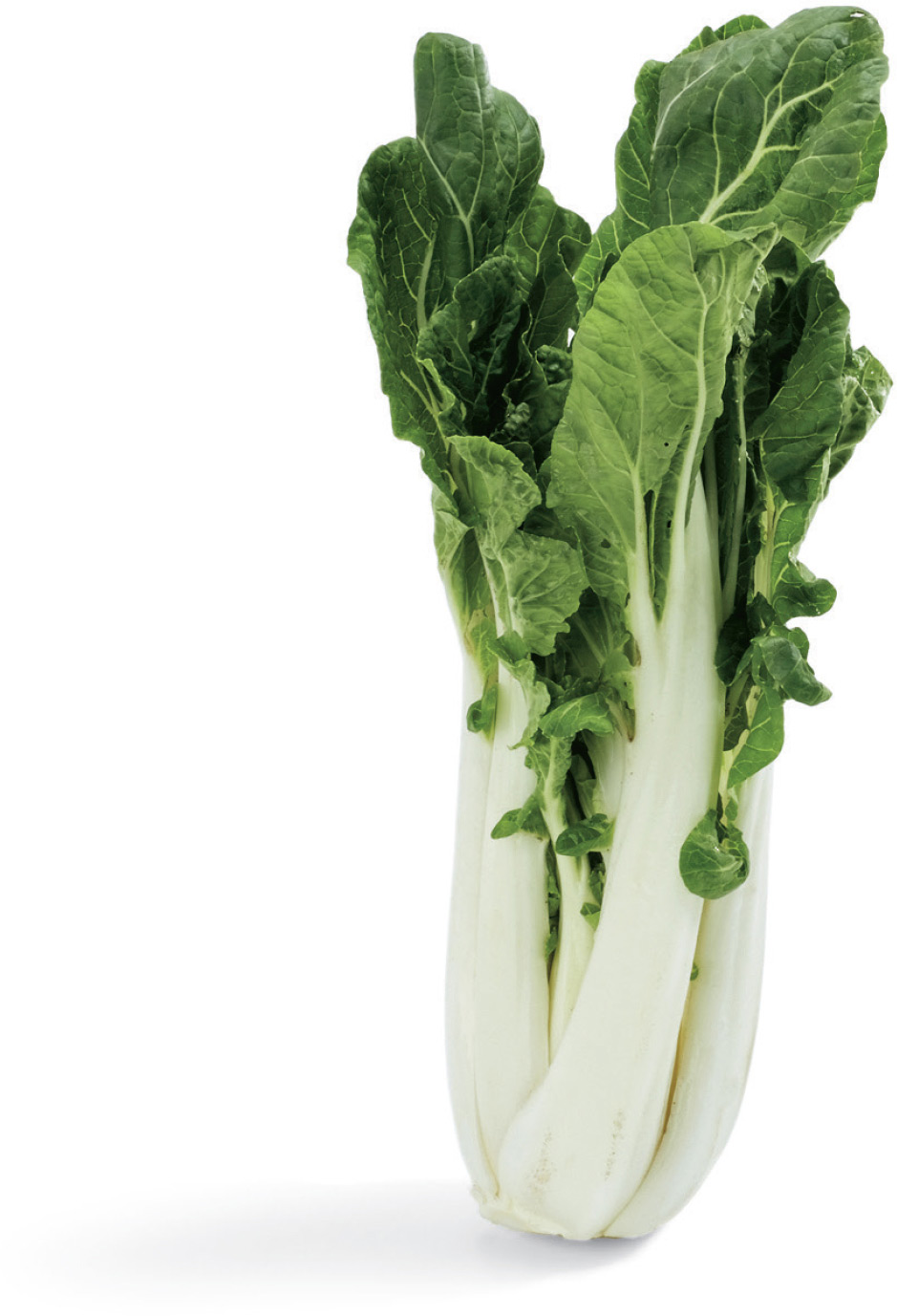
Bok choy is an Asian member of the cabbage family that has long, thick stalks topped by blue-green leaves. You probably know it as an ingredient in wonton soup, but despite that decidedly mundane use, it’s a real health food.
Is It Really a Cabbage?
There’s some minor controversy about whether bok choy, also known as Chinese cabbage, should even be called a cabbage in the first place. Technically, it’s not a cabbage, because it doesn’t form a head. In many circles, it’s more properly referred to as Chinese chard. But who cares? Whatever you choose to call it, this vegetable is a card-carrying member of the Brassica family, which means it contains indoles, compounds that have been shown to significantly lower the risk of cancer. Not only that, it’s loaded with calcium, potassium, beta-carotene, and vitamin A. All for fewer than 20 calories a cup (170 g), and even fewer if it’s raw.
Bok choy has a high-water content, so it becomes limp quickly if you overcook it. Instead, cook it quickly over a high temperature so that the leaves become tender and the stalks stay crisp. Stir-frying is ideal, but bok choy stalks are also terrific raw, used with a dip.
Raw bok choy might just be the lowest-calorie vegetable on the planet—one cup (70 g) of the shredded vegetable has exactly 9 calories. Because a cooked cup of the stuff is more concentrated, it gives several times the potassium and twice the calcium, beta-carotene, and vitamin A, plus almost 2 g of fiber. Either way—cooked or raw—it’s a bargain.
 Broccoli
Broccoli
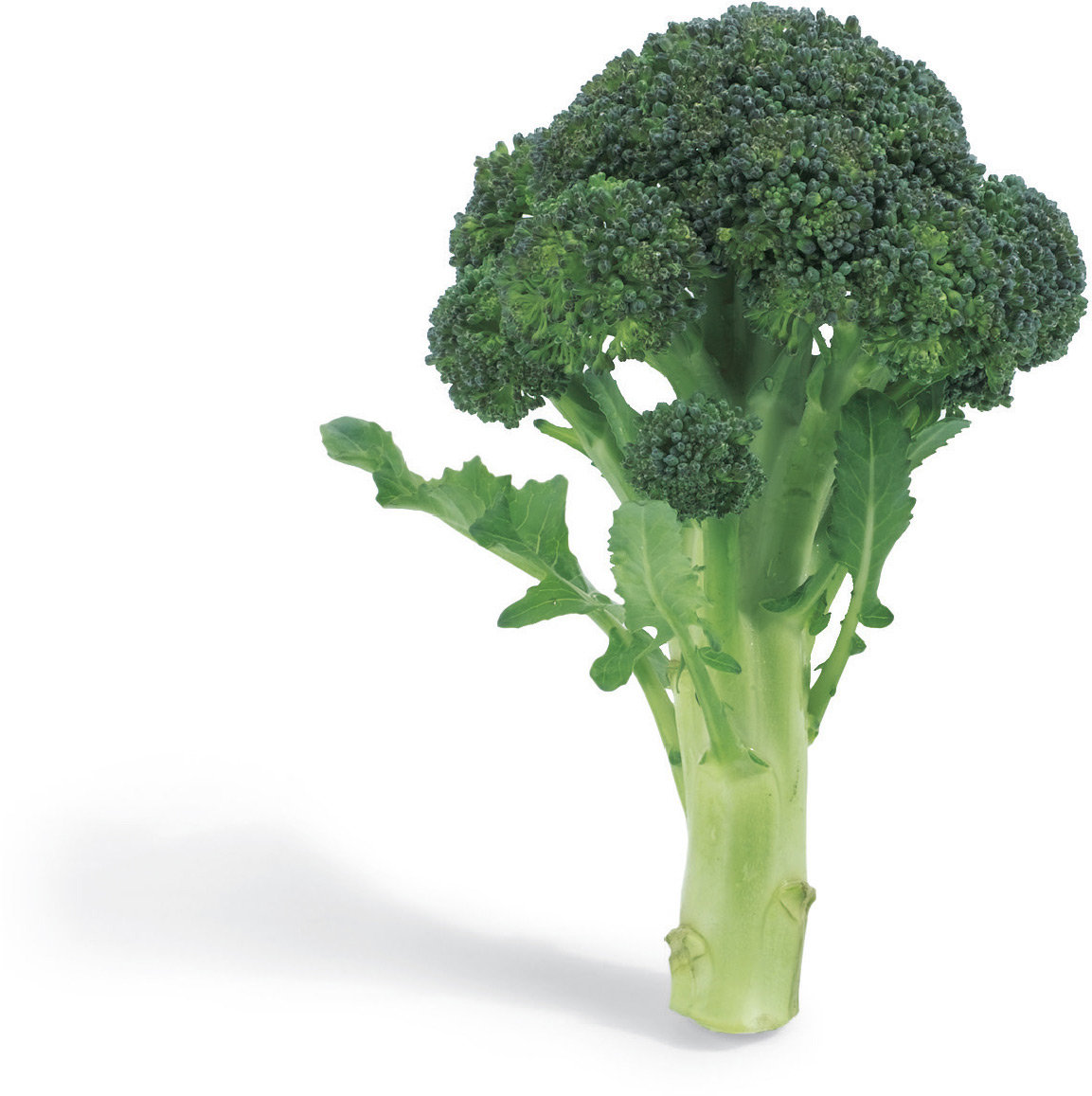
Broccoli is vegetable royalty. When I sent out a request to the best nutritionists, medical doctors, naturopaths, and researchers asking for their personal list of “top ten” healthy foods, it was almost a given that broccoli would be among the most frequently mentioned (and it was). No wonder. This superstar vegetable has been lauded for its cancer-fighting power so many times that it’s a celebrity in the nutrition world.
Broccoli is a member of the Brassica family of cruciferous vegetables—the same vegetable royalty that includes bok choy, cabbage, kale, kohlrabi, and Swiss chard. These vegetables are excellent sources of a family of anticancer phytochemicals called isothiocyanates. Isothiocyanates fight cancer by neutralizing carcinogens—the bad guys of the cancer battle. They do this by reducing their poisonous effects and stimulating the release of “carcinogen killers,” speeding up their removal from the body. Studies have shown that isothiocyanates help prevent lung and esophageal cancer and can lower the risk of other cancers, including gastrointestinal cancer. Several isothiocyanates have been shown to inhibit tumors induced by chemical carcinogens. Broccoli in particular contains a potent isothiocyanate that is an inhibitor of mammary tumors.
Why Women Should Eat More Broccoli
The anticancer properties of broccoli are well established. Even the American Cancer Society recommends eating it and other cruciferous vegetables. Though there are many compounds responsible for its impact on our health, one that deserves special mention is the indoles. Broccoli contains indole-3-carbinol, which, in addition to being a strong antioxidant and stimulator of detoxifying enzymes, seems to protect the structure of DNA. It also reduces the risk of breast and cervical cancer.
Indole-3-carbinol is of particular importance to women. Estrogen has three basic metabolites, and they behave somewhat differently in the body. Two of the metabolites—16-alpha-hydroxyestrone and 4-hydroxyestrone—have carcinogenic action, but the third, 2-hydroxyestrone, is benign and has protective effects. Indole-3-carbinol increases the ratio of the “good” (benign) estrogen metabolite to the potentially harmful ones. Men have estrogen also, and it stands to reason that broccoli and other cruciferous vegetables containing indoles should be helpful and protective to them as well. In addition, indole-3-carbinol has been shown to protect against the carcinogenic effect of pesticides and other toxins.
Note: Indole-3-carbinol is available as a supplement, but I don’t recommend it. Instead, I always recommend DIM, a metabolite of indole-3-carbinole that is safer and more reliable as a supplement and accomplishes the same thing.
Cruciferous vegetables such as broccoli also contain high levels of a phytochemical called sulforaphane. Sulforaphane increases the activation of enzymes known as phase-2 enzymes, which help fight carcinogens. It’s believed that phase-2 enzymes may reduce the risk of prostate cancer. Per research from the Department of Urology at Stanford University published in Cancer Epidemiology Biomarkers and Prevention, sulforaphane is the most potent inducer of phase-2 enzymes of any phytochemical known to date.
A Nutritional Powerhouse
Even apart from its demonstrated cancer-fighting ability, broccoli is a nutritional powerhouse. One cup (71 g) contains more than 2 g of protein, 2 g of fiber, 288 mg of potassium, 43 mg of calcium, 81 mg of vitamin C, plus folate, magnesium, phosphorus, beta-carotene, vitamin A, and 1,277 mcg of the superstars of eye nutrition, lutein and zeaxanthin. Lutein and zeaxanthin, both members of the carotenoid family, are being extensively researched for their demonstrated ability to reduce or prevent macular degeneration, the number one cause of blindness in older adults.
And, by the way, the broccoli head is actually the flower of the plant. But according to natural foods expert Rebecca Wood, cofounder of the East West Center in Boulder, Colorado, there are plenty of nutrients in the stalks as well. She suggests peeling the fibrous skin off the stalks and using them. She also suggests using the leafy greens, which offer tons of nutrients as well.
Broccoli Rabe
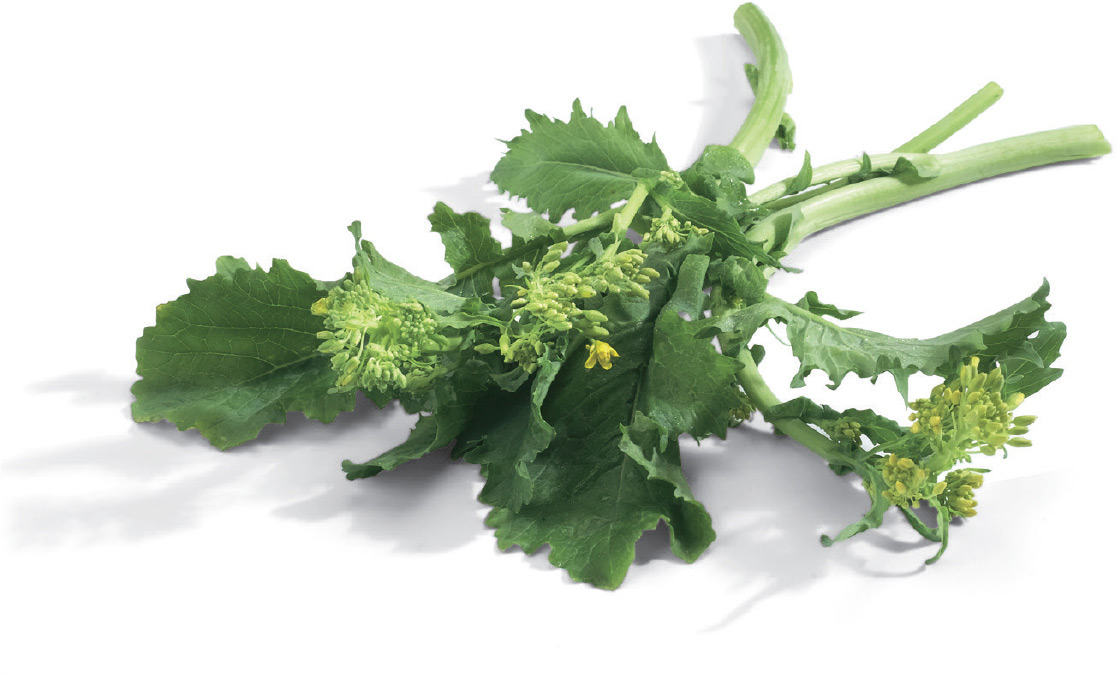
Broccoli rabe is a distant relative of broccoli, and is in fact a lot more closely related to the turnip (it’s often called a turnip green). But from the point of view of taste, you might think of it as broccoli on steroids. To put it mildly—no pun intended—it’s aggressive and bitter. The Chinese variety, also known as flowering cabbage, is milder.
But make no mistake—this peppery little plant is a card-carrying member of one of the largest edible-plant families —the Brassica family—which includes such nutritional and health heavyweights as cabbage, broccoli, Brussels sprouts, bok choy, and kohlrabi. And it shares many of their amazing health benefits. Like all cruciferous vegetables, broccoli rabe contains flavonoids, sulforaphane, and indoles, which help prevent cellular degeneration and may help protect against cancer. Sulforaphane, for example, has been shown to induce powerful enzymes that protect rodents from tumors. And flavonoids in general have extensive biological properties that promote human health and help reduce the risk of disease.
Great for Healthy Bones and Superb Vision
This immune-boosting vegetable packs an incredible nutritional wallop for a tiny number of calories. One serving, a mere 28 calories, contains 100 mg of calcium, 292 mg of potassium, 31 mg of vitamin C, 60 mcg of folate, 217 mg of bone-building vitamin K, and more than 3,800 IUs of vitamin A, including 2,300 mcg of beta-carotene. Also, there are 1,431 mcg of the superstars of eye nutrition, lutein and zeaxanthin, which are being investigated for their ability to fight macular degeneration, the number-one cause of blindness in elderly adults. For its paltry 28 calories, broccoli rabe also contains a healthy helping of fiber—2.4 mg per single serving. This is one great vegetable!
How to Prepare Broccoli Rabe
About the taste: Blanching the leaves and shoots before cooking will tame their flavor, though many people like it and use it to spice up dishes. Sophie Markoulakis of the San Francisco Chronicle recommends sautéing blanched broccoli rabe in olive oil and garlic for about 10 minutes and adding it to cooked pasta with a little cooking liquid, finely chopped dried figs, and toasted pine nuts. “Sprinkle with ricotta salata or other dried salted sheep’s milk cheese and pass the pepper grinder,” she says. Does that not sound amazing?
 Brussels Sprouts
Brussels Sprouts
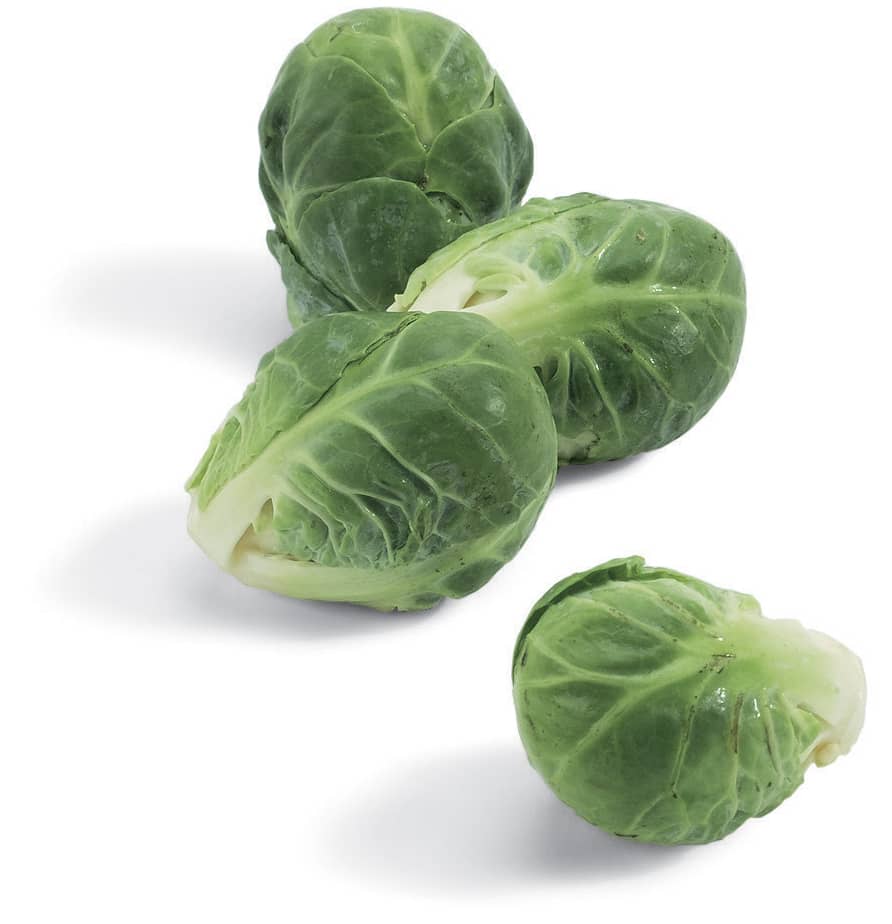
Brussels sprouts are not really sprouts at all, but members of the cabbage family, which makes sense because that’s exactly what they look like: tiny little miniature cabbages, growing tightly packed together on a tall, thick stalk. They were first widely cultivated in sixteenth-century Belgium, which accounts for their name.
Members of the cruciferous vegetable family, they have many of the same nutritional benefits of other cabbages. Cabbages in general probably contain more cancer-fighting nutrients than any other vegetable family. One of the key dietary recommendations of the American Cancer Society is to include these cruciferous vegetables in your diet on a regular basis.
Brussels Sprouts May Ward Off Colon Cancer
Brussels sprouts contain a chemical called sinigrin, which suppresses the development of precancerous cells. The breakdown product of sinigrin (allyl isothiocyanate) is the active ingredient in Brussels sprouts and is responsible for the characteristic smell of sprouts. It works by persuading the precancerous cells to commit suicide—a natural process called apoptosis—and so powerful is the effect that it’s entirely possible that the occasional meal of Brussels sprouts could help reduce the incidence of colon cancer.
Brussels sprouts are high in isothiocyanates and sulforaphane, which are compounds known to help fight cancer by inhibiting cell proliferation, neutralizing carcinogens, and helping to detoxify nasty environmental toxins. Sulforaphane, a particularly potent member of the isothiocyanate family, increases the production of certain enzymes known as “phase-2 enzymes,” which can disarm damaging free radicals and help fight carcinogens. It’s believed that phase-2 enzymes may reduce the risk of prostate cancer. Department of Urology at Stanford University research published in Cancer Epidemiology Biomarkers and Prevention, says that sulforaphane is the most potent inducer of phase-2 enzymes of any phytochemical known to date. And in a review article from the 11th Annual Research Conference on Diet, Nutrition, and Cancer from the American Institute of Cancer Research, the authors stated that “isothiocyanates are well-known protectors against carcinogenesis.”
 Cabbage
Cabbage

In the world of vegetables, the Brassica family is true royalty. And the reigning king of the brood—which includes broccoli, kohlrabi, cauliflower, bok choy, Brussels sprouts, and chard—is the cabbage. When we speak of cabbage, we’re really talking about the large, lettuce-like head that has been a staple for at least two millennia. Eaten raw, it’s the stuff of slaws. Cooked, it is hard to ignore, as even slight overcooking produces the smell of rotten eggs. But cabbage can be a delicious vegetable. And even more to the point, the cabbage family is probably the most important vegetable in the world from the point of view of nutritional benefits and cancer-fighting ability.
Cabbage Keeps Breast Cancer at Bay
Cabbage first came to the attention of researchers after they observed that women in Eastern European countries surrounding Poland and Russia were much less likely to develop breast cancer than American women, according to author and researcher Laurie Deutsch Mozian, M.S., R.D. An analysis of their diet revealed a much higher intake of cabbage, and when the cabbage was analyzed, likely candidates for the effect were the phytochemicals called indoles. Years of research have now demonstrated that these indoles, in fact, alter estrogen metabolism in a favorable way, one that is likely to reduce the risk of cancer.
Here’s how it works. Estrogen has three basic metabolites, and they behave somewhat differently in the body. Two of the metabolites—16-alpha-hydroxyestrone and 4-hydroxyestrone—have carcinogenic action, but the third, 2-hydroxyestrone, is benign and has protective effects. Indole-3-carbinol, one of the main indoles in cabbage, increases the ratio of the “good” (benign) estrogen metabolite to the potentially harmful ones. Men have estrogen also, and it stands to reason that the indoles in cabbage should be helpful and protective to them as well. In addition, indole-3-carbinol has been shown to protect against the carcinogenic effect of pesticides and other toxins.
Note: Indole-3-carbinol is available as a supplement, but I don’t recommend it. Instead, I always recommend DIM, a metabolite of indole-3-carbinole that is safer and more reliable as a supplement and accomplishes the same thing.
The anticancer benefits of cabbage don’t stop with the indoles, though. Other phytochemicals that pack an anticancer wallop and are plentiful in cabbage include dithiolethiones, isothiocynates, and sulforaphane. Sulforaphane, a particularly potent member of the isothiocyanate family, increases the production of certain enzymes known as phase-2 enzymes, which can disarm damaging free radicals and help fight carcinogens. It’s believed that phase-2 enzymes may reduce the risk of prostate cancer. Sulforaphane is the most potent inducer of phase-2 enzymes of any phytochemical known to date, according to research from the Department of Urology at Stanford University published in Cancer Epidemiology Biomarkers and Prevention. And in a review article from the 11th Annual Research Conference on Diet, Nutrition, and Cancer from the American Institute for Cancer Research, the authors stated that “isothiocyanates are well-known protectors against carcinogenesis.”
More Than Just a Pretty Plant
Red or purple cabbage is also a source of anthocyanins, pigment molecules that make blueberries blue and red cabbage red. They’re found in many colorful fruits such as grapes and berries. Turns out they do a lot more than make our produce pretty. Anthocyanins belong to a group of plant compounds called flavonoids, and they have considerable bioactive properties, including acting as powerful antioxidants. In one study anthocyanins were found to have the strongest antioxidizing power of 150 flavonoids studied (more than 4,000 different flavonoids have been identified). And the anthocyanins in red cabbage were found in another study to protect animals against the damages produced by a known toxin. There’s every reason to think that they’re equally protective for us.
Anthocyanins’ ability to act as antioxidants and to fight free radicals make them powerful weapons against cardiovascular disease. And anthocyanins are also known for their anti-inflammatory effects. Anti-inflammatory anthocyanins can help dampen allergic reactions as well as help protect against the damage to connective tissue and blood vessel walls that inflammation can cause.
On top of all its phytochemical power, cabbage is a darn good source of everyday vitamins and minerals. It contains calcium, magnesium, potassium, vitamin C, vitamin K, beta-carotene, and even a little of the eye-healthy carotenoids, lutein and zeaxanthin. And let’s not forget the fiber. One cup (150 g) of the cooked stuff gives you almost 4 g of fiber. One cup (89 g) of raw cabbage gives you 2 g. All this in one of the lowest-calorie foods on the planet.
 Carrots
Carrots
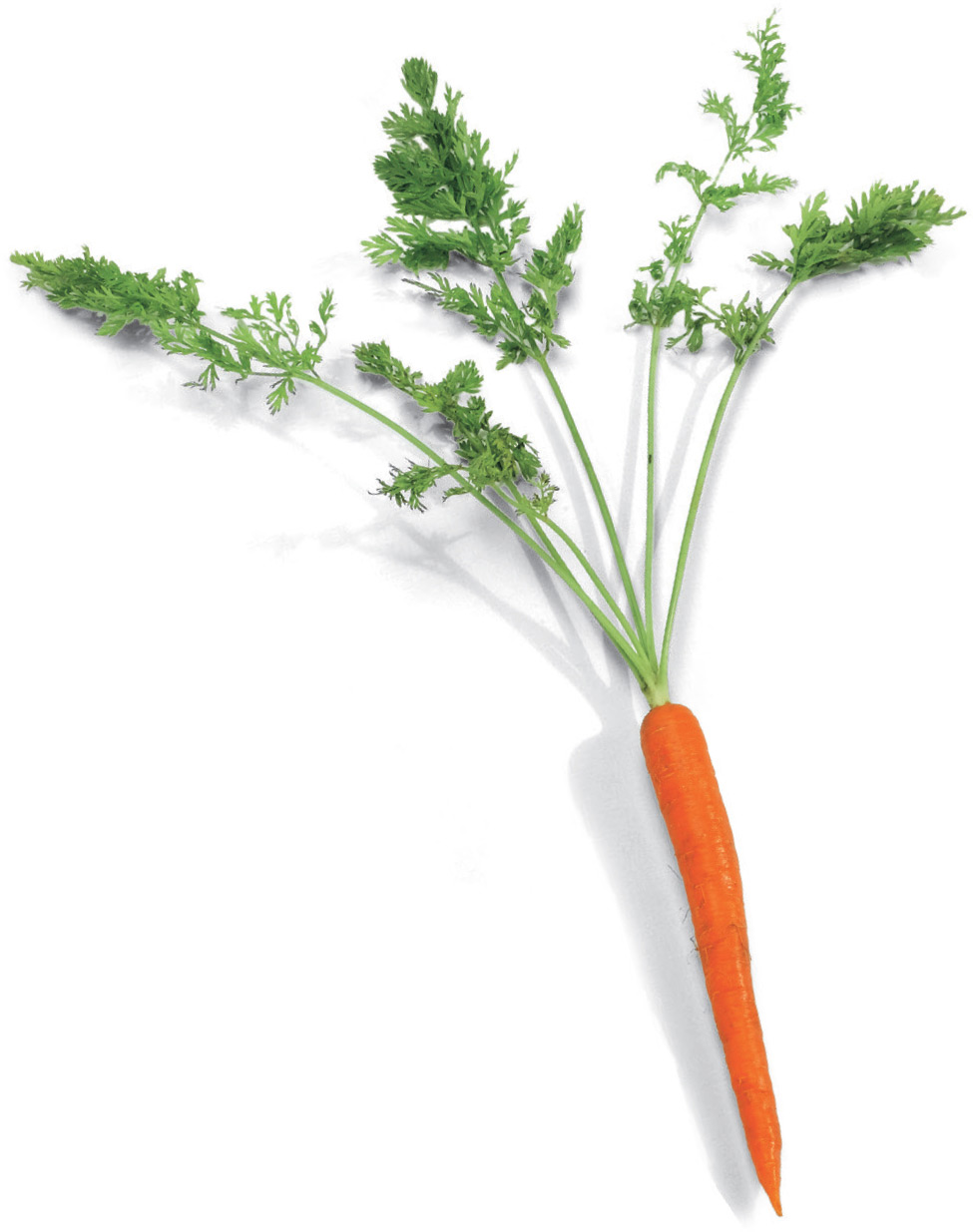
What’s the very first thing you think of if someone uses the term “healthfood?” For many people, it’s carrots. Well-known naturopathic physician Michael Murray, N.D., calls carrots “the king of the vegetables,” and for good reason. Human studies have indicated that as little as one carrot a day could possibly cut the rate of lung cancer in half.
The cancer-fighting properties of this great vegetable should be taken seriously. Carrots are high in carotenoids, antioxidant compounds found in plants that are associated with a wide range of health benefits. You’ve probably heard good things about betacarotene, but that’s only one of about 500 members of the carotenoid family. Some research suggests that other carotenoids may be even more important. High carotenoid intake has been associated with a decrease of up to 50 percent in bladder, cervical, prostate, colon, larynx, and esophageal cancer, as well as up to a 20 percent decrease in postmenopausal breast cancer.
Carrots are also high in alpha-carotene, another carotenoid that appears to have health benefits of its own. In fact, one report published in NCI Cancer Weekly by Michiaki Murakoshi, who led a team of biochemists at Japan’s Kyoto Prefectural University of Medicine, contends that alpha-carotene may be more powerful than beta-carotene in inhibiting processes that may lead to tumor growth.
Although one badly designed study a few years ago seemed to indicate that beta-carotene by itself had no value in preventing cancer, what wasn’t well publicized is that the study subjects were heavy smokers and that the beta-carotene given to them was a synthetic kind that behaves differently in the body than the real deal. The real lesson from that study is that the carotenoids perform best working as a unit, and should be obtained in their natural—not synthetic—form. Dozens of studies show beneficial associations between eating fruits and vegetables high in carotenoids and less cardiovascular disease, not to mention less prostate, lung, stomach, colon, breast, cervical, and pancreatic cancer, according to Walter Willett, M.D., Dr. P.H., professor of epidemiology and nutrition at Harvard’s School of Public Health.
Why Your Mom Was Right about Carrots
Put carrots in the column labeled “things mother was right about after all.” Carrots really are good for your eyes. They’re a great source of lutein and zeaxanthin, two other carotenoids that, when working together, have shown enormous promise in protecting the eyes and helping to prevent macular degeneration and cataracts. Both alpha-carotene and beta-carotene convert in the body to vitamin A, which, in addition to being a great antioxidant and immune system stimulator, turbocharges the formation of a purple pigment in the eye called rhodopsin. Rhodopsin is needed by the eye to see in dim light—it raises the effectiveness of the light-sensitive area of the retina—so not getting enough vitamin A can lead to night blindness.
Three medium carrots contain 60 mg of calcium, 586 mg of potassium, a little bit of magnesium, phosphorus, and vitamin C, and of course, a whopping 30,000 IUs of vitamin A, including 15,000 units of beta-carotene and 6,000 of alpha-carotene. They also have 5 g of fiber.
Cooked Carrots Prevail
Cooking slightly changes the nutritional content and makes some of the nutrients more bioavailable. But both raw and cooked carrots are healthy.
To get the most out of the carotenoids found in carrots, eat them with a little fat. The carotenoids and vitamin A are fat-soluble nutrients and are better absorbed that way.
Finally, carrots are a favorite ingredient for juicing, and carrot juice is often used as part of a detoxification program. Just be aware that when you juice carrots you’re using a lot of them, plus you’re removing the fiber, both of which increase the concentration of sugar. That doesn’t mean it’s not a fantastically healthy juice ingredient, just something you should be aware of if you’re sensitive to blood sugar fluctuations. Juicing carrots with some low-sugar vegetables such as spinach and broccoli lessens the impact.
Cauliflower

For a long time now, common nutritional wisdom has held that the best diets are rich in colors (green as in spinach, blue as in blueberries, red as in peppers) and low in “the white stuff” (sugar, potatoes, white bread, rice, Twinkies, spaghetti, and the like). I agree with that wholeheartedly. But there are three exceptions to “anti–white stuff” dictum: whitefish, mushrooms, and cauliflower.
Cauliflower is a member of the Brassica or cabbage family and, as such, contains many of the compounds, like indoles, that have given this vegetable family its rightly deserved reputation as a potent cancer fighter.
In addition to indoles, cauliflower contains sulforaphane, a breakdown product of compounds in the cauliflower called glucosinolates. While glucosinolates themselves typically have low anticancer activity, sulforaphane has plenty! Sulforaphane was first identified in broccoli sprouts by scientists at the Johns Hopkins University School of Medicine. It’s one of a class of chemicals in plants called isothiocyanates and is a potent antioxidant and stimulator of natural detoxifying enzymes in the body.
How Does Cauliflower Fight Cancer?
Here’s how it works: Within minutes of being eaten, sulforaphane enters the bloodstream and turbocharges the body’s antioxidant defense systems. When it reaches the cells, it activates phase-2 detoxification enzymes in the liver, which then “disarm” carcinogenic molecules and help remove them from the cells. Sulforaphanes, along with other isothiocyanates and indoles is believed to be responsible for the lowered risk of cancer that’s associated with the consumption of cruciferous vegetables such as cauliflower, kale, cabbage, and, of course, broccoli and broccoli sprouts.
How to Make Fake Mashed Potatoes
A cup (124 g) of cauliflower is ridiculously low in calories, and contains 3 g of fiber as well as over 50 mg of vitamin C, 176 mg of potassium, and 55 mcg of folate.
The vegetable got a much-deserved boost when the author of The South Beach Diet, Arthur Agatston, M.D., popularized a fabulous fake mashed potatoes made using cauliflower in place of the potatoes. With a little butter, lemon, and sea salt, it is beyond delicious. (Of course, my friend and fellow author Dana Carpender was making “fauxtatoes” way before The South Beach Diet was ever published, but don’t get me started.)
Celery
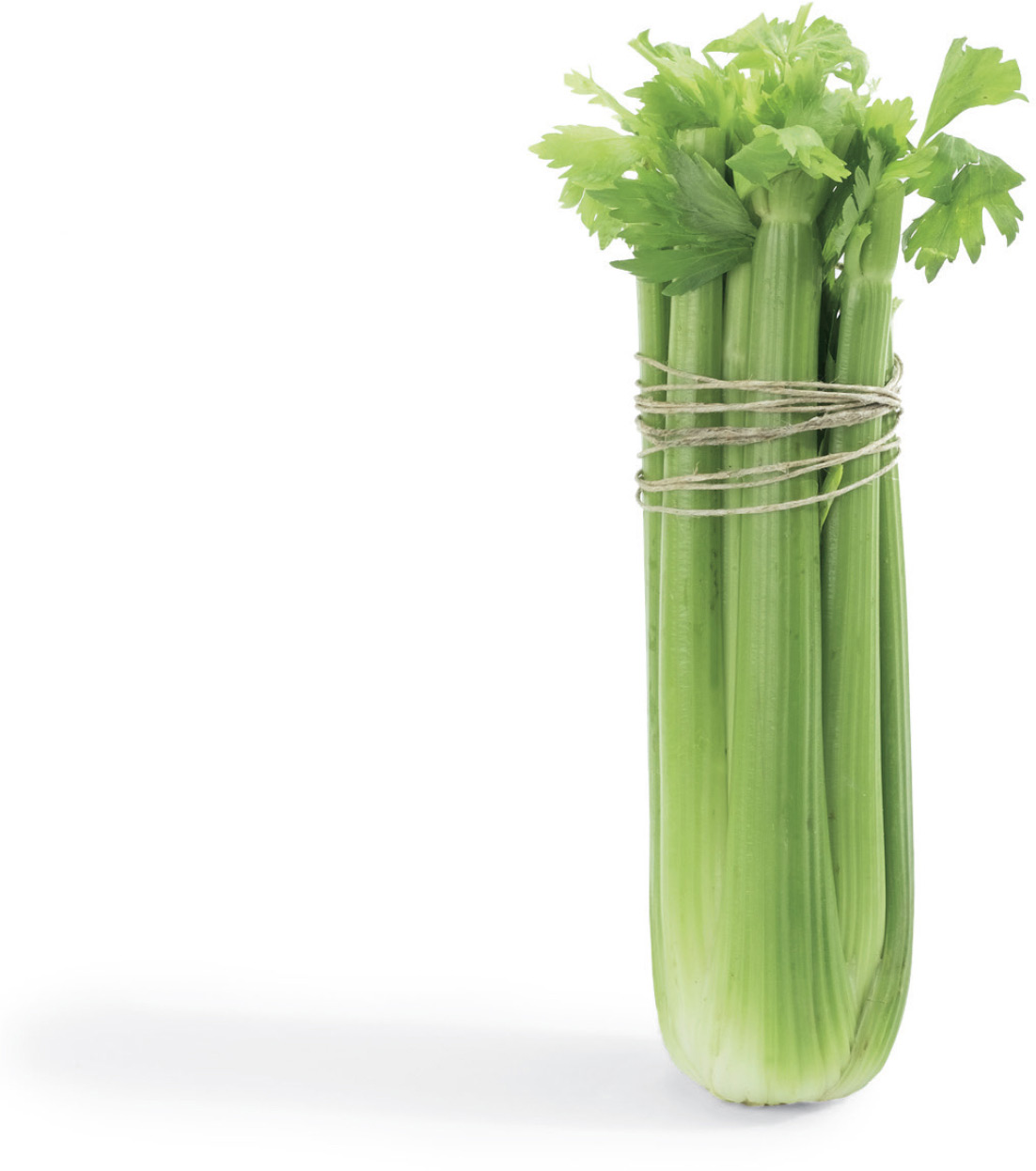
I’m a big fan of celery for a lot of reasons. It’s terrific for appetite control and can be used at the end of a meal (or any time) to stem carb cravings. Smear a spoonful of almond butter or natural peanut butter on it and you have a perfect low-sugar snack that’s pretty filling. Celery—with or without the almond butter—travels well in plastic or glass containers. Chewing it stimulates saliva and can aid in digestion. It’s a terrific addition to fresh juice (more about that in a moment). And that’s just for openers.
Celery Number One for Treating High Blood Pressure
Celery just might be the number one medicinal food for blood pressure. It’s been recommended in traditional Chinese medicine for high blood pressure for centuries, and experimental evidence has confirmed its usefulness.
In one study, injecting lab animals with celery lowered their blood pressure by 12 to 14 percent. If you’re a human, you’d get that effect with about four ribs. Mark Houston, M.D., director of the Hypertension Institute in Nashville and my go-to guy for all things related to hypertension, has celery at the top of his list of foods for his patients with high blood pressure. The substances in celery that seem to produce the benefit are phytochemicals called phthalides. Clinical studies show that they work by relaxing the muscle tissue in artery walls and therefore increasing blood flow. Phthalide also helps lower levels of stress hormones.
The Celery Hangover Cure
Here’s a little folk legend for you: In ancient Rome, they used to wear celery around the neck to ward off a hangover after a particularly demanding night of Roman-style partying. It might be that this is where the practice of putting a stick of celery in a Bloody Mary came from, but that could just be urban legend.
Celery is also a great source of silicon, which is getting a lot of attention recently as a very important nutrient for bone health. Because of its silicon content, celery can help renew joints, bones, arteries, and all connective tissue.
There’s also an ingredient found in celery called acetylenics, which has been shown to stop the growth of cancer cells. Celery also contains phenolic acids. These have been shown to block the actions of prostaglandins, which are known to encourage the growth of cancerous tumors.
Give Celery Juice a Try
In Asian traditions, celery is one of the few vegetables that combines well with fruit. Personally, I love it as a base for fresh juice. One of my absolute favorites: Combine a few ribs with one pear and a couple of inches of gingerroot.
Collard Greens

If you’ve ever wondered what people mean when they use the expression “soul food,” this is the food they’re talking about. This cabbage-family vegetable was brought to these shores by African slaves and is a staple of Southern cooking. Its flavor lies somewhere between cabbage and kale. It’s your quintessential green leafy vegetable, and, in fact, is usually sold as a loose bunch of leaves, though you can get it frozen as well. The fresh version needs to be cleaned thoroughly before cooking.
Typically, collards are simmered for several hours, which makes them tender. But you can also boil them in water for 15 to 30 minutes if you don’t mind them being a bit firmer. In Southern cooking, they’re often cooked with bacon or salt pork, but they don’t have to be; they’re often served with beans, especially black-eyed peas (also optional). Personally, I think they’re outstanding with just sweet butter and sea salt.
Collards are members of the family of cruciferous vegetables and provide valuable cancer-fighting phytochemicals. One cup (190 g) of collards provides almost the same amount of calcium as 8 ounces (235 ml) of milk, and 5 whopping grams of fiber in the bargain. In addition, they’ve got magnesium, phosphorus, more than 200 mg of heart-friendly potassium, vitamin C, and a ton of vitamins A and K. There’s also a meaningful amount of beta-carotene. And if all that weren’t enough, they are a significant source of lutein and zeaxanthin, two carotenoids that are fast becoming the go-to nutrients for eye health.
 Dandelion
Dandelion
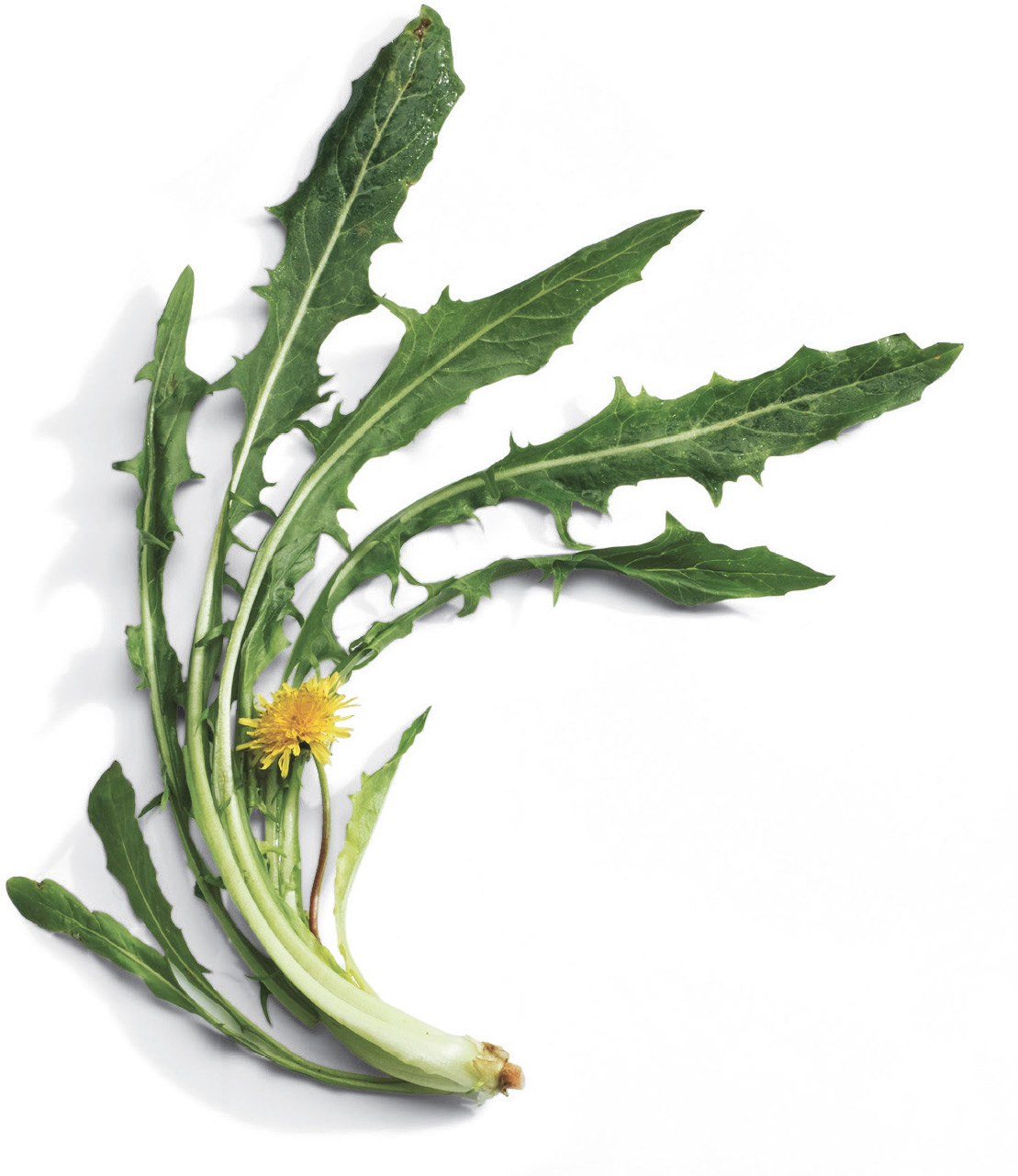
The Latin name for dandelion—Taraxacum officinale—is your first clue as to what this plant is about. Loosely translated, it means “official remedy for the disorders.” (In Greek, taraxons means “disorder,” and akos means “remedy.” The Arab physicians of the eleventh and twelfth centuries who were the first to write about this miracle plant called it taraxacon.) Dandelion is used in herbal traditions all over the world, including by Native Americans, Arabs, Chinese, and Europeans.
Louis Vanrenen, in his excellent little book Power Herbs, lists it as one of the top fifty power herbs. Yup, we’re talking about the same dandelion that many people consider a weed. But as Ralph Waldo Emerson said, a weed is just a plant whose virtues have not yet been discovered. This weed has a distinguished history of medicinal use in China, Japan, Russia, and Europe, and it has been used for detoxification for more than a century.
Dandelion Improves Your Liver and Your Moods
Probably at the top of the list of dandelion’s health benefits is its profound effect on the liver. Dandelion ranks right alongside milk thistle as the most frequently recommended herbs to help patients who need liver detoxification, says Mark Stengler, N.M.D. The liver’s job is to detoxify every chemical, pollutant, and medicine that we’re exposed to—according to some experts it performs more than 5,000 enzymatic reactions. That means keeping it strong and functioning smoothly is of prime importance to our health. “Just by treating the liver we can sometimes resolve numerous conditions ranging from physical problems such as indigestion and hepatitis to the emotional imbalances that contribute to irritability and depression,” says Stengler. Dandelion root figures prominently in many natural nutritional support programs for hepatitis C.
One of the chemical components of dandelion, taraxacin, is thought to stimulate the digestive organs and help prompt the liver and gallbladder to release bile. This can be useful in constipation and indigestion—bowels move more easily with increased bile flow, and unlike pharmaceutical laxatives, dandelion can be taken for a few months. Christopher Hobbs, a licensed acupuncturist and fourth-generation herbalist and botanist with more than 35 years of experience with herbs, writes that clinical and laboratory research on dandelion shows “a doubling of bile output with leaf extracts and a quadrupling of bile output with the root extract.” Bile helps with the digestion and absorption of fats; this might explain how effective dandelion is in helping with heartburn and indigestion.
Dandelion Root for Diabetes
Dandelion root is also helpful in the treatment of diabetes. It contains inulin, which is a naturally occurring type of soluble fiber known to have a positive effect on blood sugar levels. Inulin also increases calcium absorption and possibly magnesium absorption while promoting probiotic bacteria. In addition, dandelion also contains some pectin, another type of fiber that helps relieve constipation and reduce cholesterol. (Pectin is also found in apples.)
Dandelion is a natural diuretic. Want something for bloat and water retention? This is your natural medicine. One of the nice benefits of using it as a diuretic is that it does not cause loss of potassium. Dandelion leaf extract works great for the water retention of PMS, and Stengler routinely uses it for edema of the lower legs and ankles that he sees in elderly patients (edema is swelling or bloating caused by fluids in the extremities).
Dandelion also contains two hormone-balancing constituents, taraxerol and taraxasterol. “It’s one of the premier herbs recommended for hormone-related conditions like PMS,” says Stengler. Because it’s a natural diuretic, dandelion leaf is a wonderful aid in reducing high blood pressure. (Note: Never discontinue a blood pressure medication without the approval of your health professional.)
Why It Ranks in the Top Four of All Green Vegetables
If all this weren’t enough, dandelion is one of the most nutrient-rich vegetables on the planet. They rank in the top four green vegetables in overall nutritional value, according to the USDA. One cup (105 g) of cooked dandelion greens contains 147 mg of calcium, 244 mg of potassium, 203 mg of bone-building vitamin K, and a respectable 3 g of fiber. Dandelions are nature’s richest green-vegetable source of beta-carotene and the third richest source of vitamin A of all foods after cod liver oil and beef liver. One cup of the stuff contains more than 10,000 IUs of vitamin A! And just for good measure, the same cup contains 4,944 mcg of the new superstars of eye nutrition, lutein and zeaxanthin, which are being investigated for their ability to protect against the number-one cause of adult blindness, macular degeneration. Fresh dandelion greens make an excellent salad, alone or with other garden greens. You can use the bittersweet root the same way you would a carrot—in stir-fries, in soups, or sautéed with onion and garlic, says natural-foods expert Rebecca Wood. The root also makes a terrific, liver-friendly, detoxifying tea.
Eggplant
Whenever you see a richly colored vegetable or fruit, you can be sure of one thing: Nature put those colors in there to protect against something in the environment, usually the intense rays of the sun, which can cause free-radical damage if unchecked. The blue pigment in blueberries, the red pigment in raspberries and watermelon, the yellow pigments in peppers… all contain a potent array of phytochemicals that not only protect the plant from damage in its environment but also do the exact same thing for the cells and DNA in your body. And, of course, the deep, rich purple pigment in eggplant skins is no exception.
The Nutritional Power of Purple
A substance called nasunin has been isolated from that deep purple pigment. Nasunin, a member of the anthocyanin category, is a powerful antioxidant. Studies show that it literally eats up free radicals, rogue molecules in your body that can cause serious damage to your cells and your DNA and are partly responsible for aging.
In addition, nasunin protects against lipid peroxidation—that means it helps keep fats from turning rancid, including the fats in your body (such as LDL cholesterol). The brain is particularly vulnerable to oxidative damage, and studies have shown that anthocyanins in general are highly protective of animal brain tissue. Other studies show that nasunin binds to iron, which is a very good thing, as too much iron in the system can cause all kinds of problems.
Eggplant isn’t a nutritional superstar, but it’s a nice vegetable with 2.5 g of fiber in a cup (99 g) that only costs you 35 calories. Plus it’s filling. I go to an amazing little Japanese restaurant in Studio City, California, that looks exactly like the restaurants on the side streets of Tokyo, and they serve cooked eggplant in a miso-ginger sauce that will knock your socks off. You can easily make a meal out of an entire eggplant eaten that way. The eggplant itself is only 132 calories, and all you have to do is use the sauce judiciously and you’ve got a great dish. Add a couple of eggs for protein—I know it’s unconventional, but it’s great—and you’ve got a terrific and complete meal with very moderate calories.
Eggplant is also great sprinkled with olive oil. And if you’re making a big salad for the family and you can manage to include one whole eggplant sliced up, you’ll be adding a whopping 181/2 g of fiber and 1,260 mg of potassium to the mix, not to mention niacin, folate, calcium, magnesium, phosphorus, and phytosterols.
Here’s an interesting fact: Eggplant is considered a fruit, but botanically it’s a berry. Go figure. It’s related to the potato and tomato and is a member of the nightshade family.
Endive
(Belgian endive, escarole, French endive)
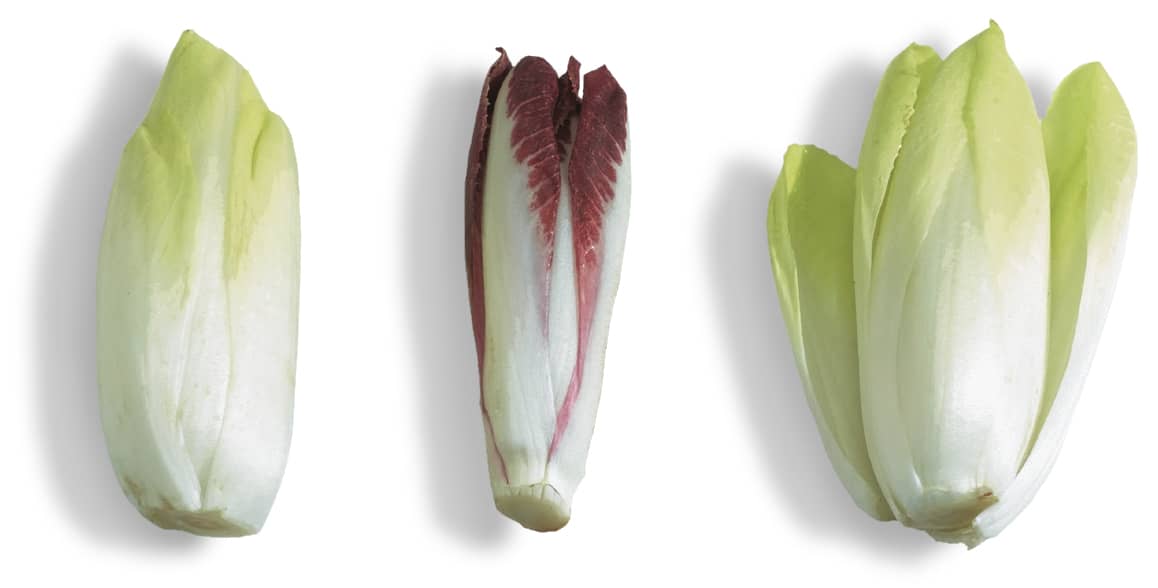
Endive is a member of the botanical family Chicorium and is a close relative of chicory, with the same characteristic of being fresh yet slightly bitter in flavor. Belgian endive—also called French endive or witloof—is a small, cylindrical head of pale, tightly packed leaves. Curly endive—sometimes wrongly called chicory—has lacy, green-rimmed, curly leaves with a prickly texture (and slightly bitter taste). Then, of course, there’s escarole, which has a milder flavor than either Belgian or curly endive.
Two cups (100 g) of endive have an awful lot of nutrients for a paltry 8 calories. There’s 26 mg of calcium, about 1/2mg of iron, 157 mg of potassium, 71 mcg of folate, more than 1,000 IUs of vitamin A (650 of beta-carotene), and 115 mg of bone-strengthening vitamin K. Now that’s a healthy salad green!
My favorite: Toss them with some walnuts and sliced pears and maybe a little blue cheese and olives. Olive oil is a nice addition to the mix.
Fennel
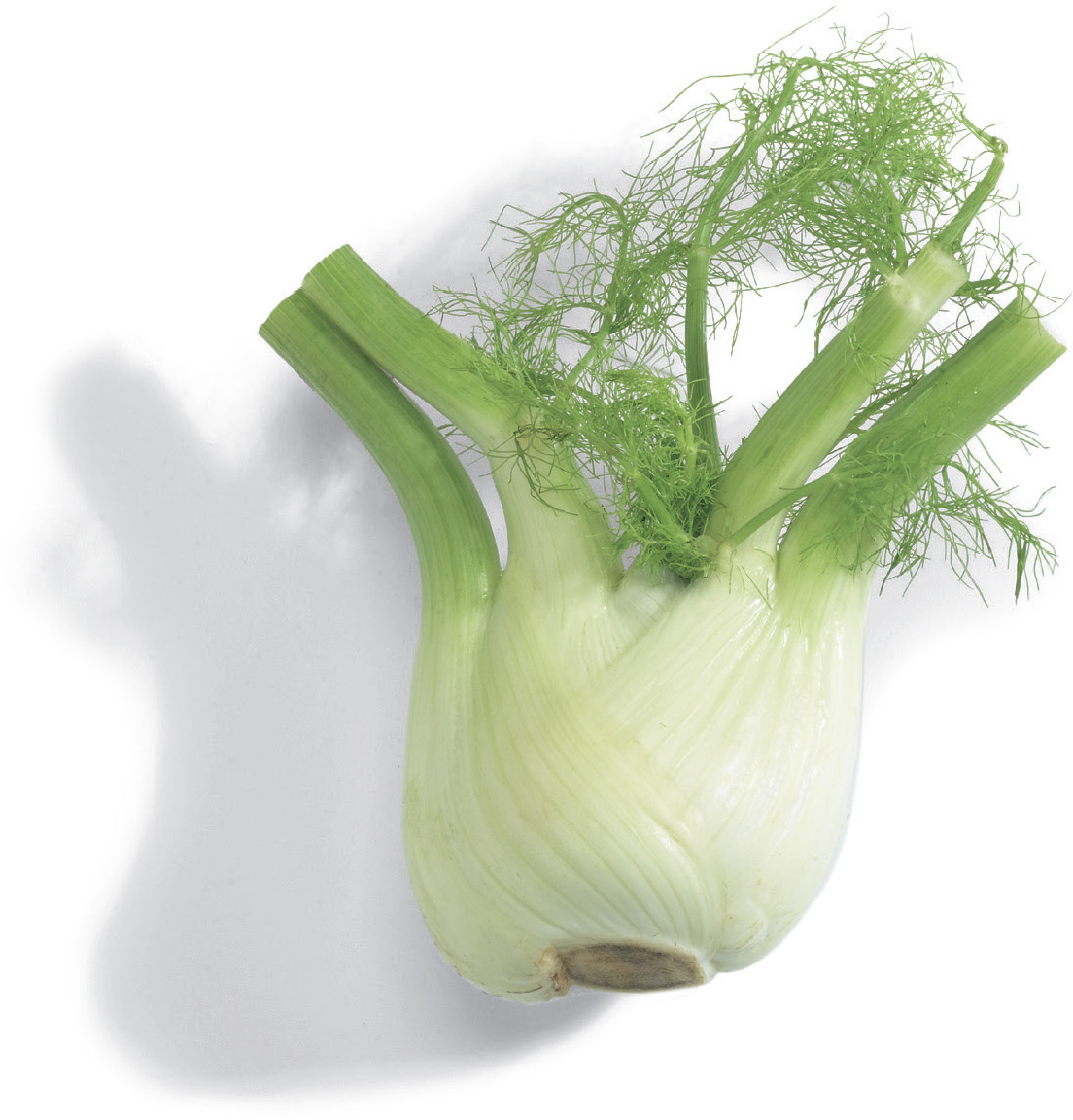
Fennel is a perfect example of how sometimes a plant will show its medicinal properties in the most unexpected conditions. Consider colic. Although common enough and thought to be benign, it’s a significant problem in infants and imparts a psychological, emotional, and physical burden on parents. The only medicine that has been shown to be effective is dicyclomine hydrochloride. But there’s one little problem. Five percent of infants treated with it develop serious side effects, including death. So if there were a benign plant-based medicine that got the job done, that would be a pretty terrific thing.
Babies Benefit from Fennel
A study published in volume 9 of the 2003 Journal of Alternative Therapy Health and Medicine tested the effect of fennel seed oil on infantile colic. Fennel eliminated colic in 65 percent of the infants, produced a significant improvement in the treatment group, and lowered the NNT (number needed to treat), all without a single side effect reported. If it can do that for infant colic, one might be forgiven for thinking that it could have other benefits as well.
And if you had that thought, you’d be right. Supplements containing different combinations of various natural herbs including fennel seed extract were tested in a study in anticancer research and found to suppress the growth of certain tumors. The dried fruit of the fennel contains an essential oil that has a rich mix of health-promoting compounds, including anethole (responsible for the licorice flavor), limonene, and quercetin (an anti-inflammatory flavonoid). In laboratory studies, fennel oil counteracts spasms of smooth muscle in the gut. It seems to relieve gas and help with cramps, and in Indian restaurants, it’s often offered on a plate after dinner for its soothing effect on the digestion and its sweetening effect on the breath. It also makes a nice tea—pour boiling water over a couple of spoonfuls of the dried fruit, crushing it immediately before using. Steep for 10 minutes and strain.
Green Beans
(and their cousins: French beans, runner beans, and Italian beans)

Let’s face it: Green beans are not a superstar of the vegetable community. Rather, they’re a good, solid utility player. If they were in an investment portfolio, they’d be Ginny Maes or savings bonds. You’re not likely to get rich on them, but they’re good, reliable performers, and they belong in your portfolio.
Yesterday’s String Beans Are Today’s Green Beans
For the purposes of this book I’m lumping all the beans in the Phaseolus vulgaris category together: that’s French beans, runner beans, snap beans, green beans, wax beans, Italian beans… you get the picture. When I was a kid we called them string beans, because in the old days (before I was born, of course) there used to be a fibrous string running the length of the pod seam, which you had to remove before cooking. Nowadays the folks who breed these things have genetically engineered them so the string is a thing of the past.
Green beans contain folate (about 10 percent of the RDI, which is too low anyway). An RDI, or Reference Daily Intake, is the replacement standard for the old RDA. But as traditional naturopath Regina Wilshire points out, the folate in green beans is bound in the proper ratio to two amino acids in the green beans, which makes it much more highly absorbed than the folate from enriched cereals. Folate is a critically important B vitamin that not only helps prevent neural tube defect, but also helps bring down homocysteine, a naturally occurring amino acid that can be harmful to blood vessels and contributes to the development of heart disease, stroke, dementia, and peripheral vascular disease (reduced blood flow to the legs and feet).
Green (string) beans have a bunch of other vitamins and minerals—a little bit of calcium, a little bit of vitamin A, and a nice dose of potassium. They also contain about 20 percent of the daily value for manganese, an important trace mineral that’s essential for growth, reproduction, wound healing, peak brain function, and the proper metabolism of sugars, insulin, and cholesterol. Throw in some beta-carotene and the eye-friendly carotenoids lutein and zeaxanthin for good measure, and about 1/2of the daily requirement for bone-building vitamin K. And a cup (125 g) of them will give you about 4 g of fiber (better than the average slice of bread and a whole lot better for you). You can eat them raw or cooked—the vitamin content changes marginally for the better when they’re cooked. They age fast once harvested, so use them quickly.
Horseradish
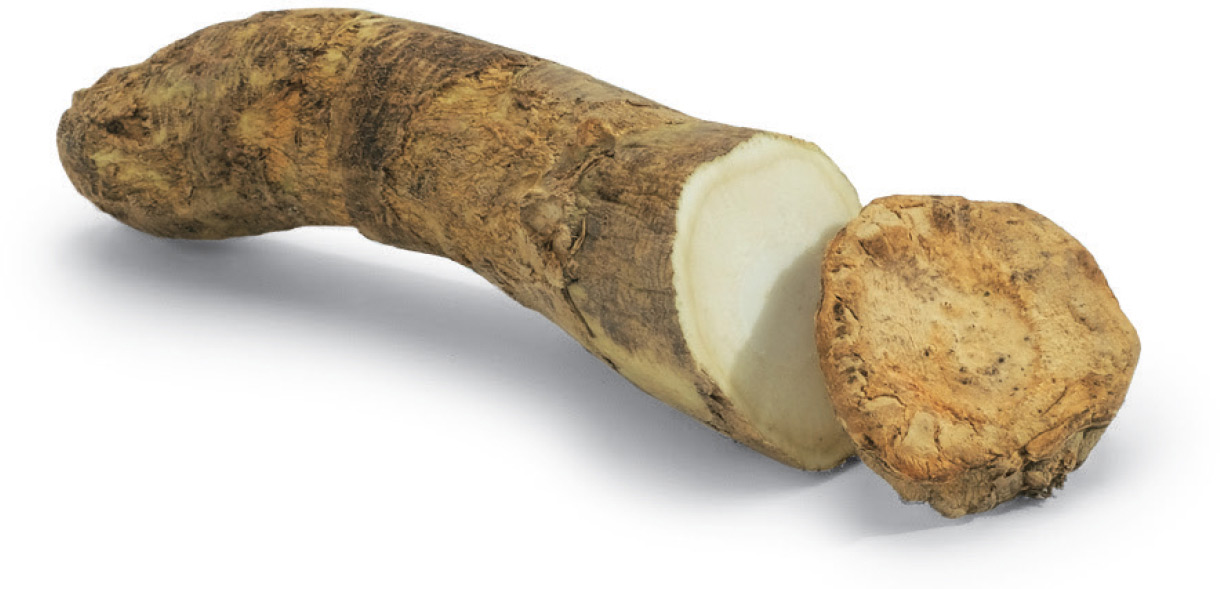
The first time I tasted horseradish was also the first time I attended a Passover Seder, where it occupies a place of honor on the dinner plate as one of the five bitter herbs representing the bitterness of slavery. Little did I imagine that decades later I would be writing about its health benefits.
Horseradish is a relative of the mustard family that acts as a digestive stimulant. It’s also great for clearing up the sinuses! It inhibits bacterial infection and increases circulation. (You might notice that you start sweating when you eat a lot of it!)
And for its tiny number of calories (14 for 2 tablespoons [30 g]) it contains a nice assortment of minerals, particularly potassium. But that’s the least of the benefits this cabbage-family member has to offer.
Why Horseradish Beats Broccoli
Horseradish is a member of the distinguished Cruciferae family, which I call “the Medici of vegetables,” whose relatives include broccoli, Brussels sprouts, cabbage, cauliflower, kale, rutabaga, and turnip. If you’ve read about any of the above vegetables in this book, you know that a significant body of research exists showing the health benefits and cancer-fighting properties of many of the compounds that have been isolated from this food family. And horseradish is one of the richest sources of allyl isothiocyanate, which is believed to play a role in the prevention of tumors and in the suppression of tumor growth.
A study from the University of Illinois shows that horseradish has substantial quantities of glucosinolates, compounds that are the parent molecules of substances that increase human resistance to cancer. Glucosinolates in food increase the liver’s ability to detoxify carcinogens and, according Mosbah Kushad, Ph.D., associate professor in the department of crop sciences at the University of Illinois, they may suppress the growth of existing cancerous tumors. Kushad, who has been involved in studies of many cruciferous vegetables, says that horseradish contains ten times more glucosinolates than broccoli, so you don’t need as much to benefit. “A little dab on your steak will go a long way to providing the same health benefits as broccoli,” he says.
Horseradish may be one of the few foods in this book that improves with processing. It contains an enzyme that breaks down these valuable glucosinolates into other compounds—isothiocyanates—that are responsible for the anticancer benefits: When you process the stuff, that enzyme is released. The enzyme, in turn, encounters the glucosinolates, and presto, you’ve got the nutritionally beneficial isothiocyanates.
Jerusalem Artichokes
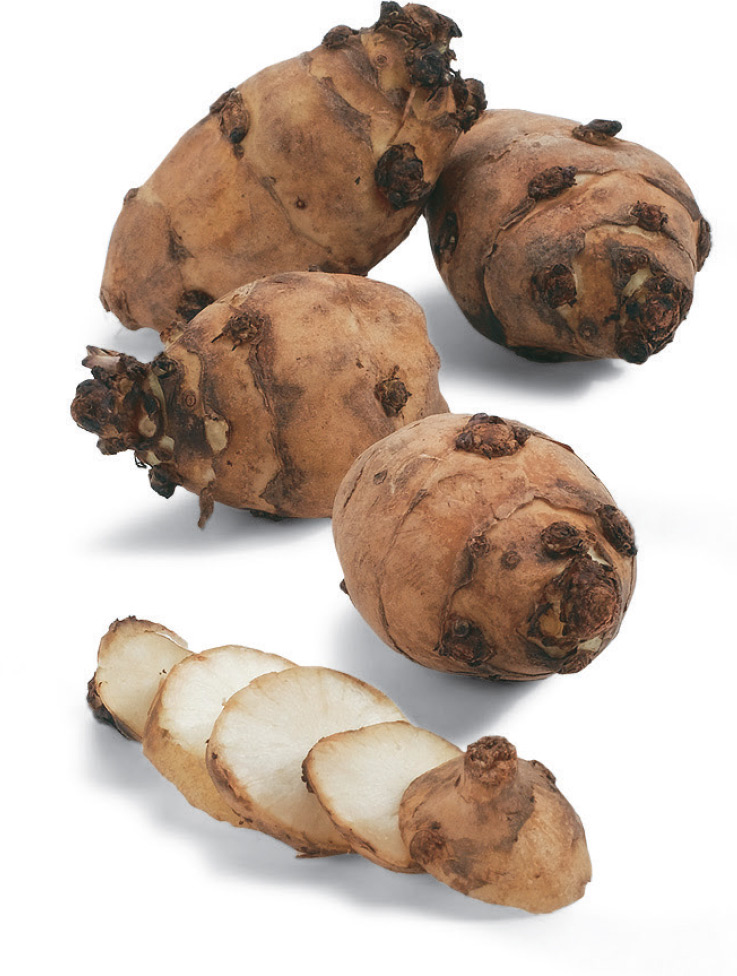
Jerusalem artichokes aren’t really artichokes; plus, they’re not even from Jerusalem. They’re a member of the sunflower family and are also referred to as sunchokes, kind of a cross between artichoke and sunflower. They probably got the name Jerusalem because it sounded like girasol, which is the Italian name for sunflower. This large yellow flower—which is very pretty, by the way—was cultivated by the Native Americans, who prepared the tubers for Lewis and Clark in 1805 (in what is now North Dakota). The tuber—or underground stem—resembles a gnarly potato or a piece of ginger, and it has a nice taste. The baked tubers are delicious.
Feeding the Good Bacteria for a Healthy Gut
Whatever the genesis of its odd name, this vegetable lands on the list because of its high content of fructooligosaccharides and inulin. What are those, you ask? They’re what we now call prebiotics—extremely healthy food for the “good” bacteria in your gut.
You know how antibiotics wipe out all the bacteria in your gut garden, including the healthy kind like acidophilus? Well, the good bacteria in your gut love to dine on fructooligosaccharides—they’re health food for those good bacteria, and thereby help you to maintain a healthy gut ecology. That’s why they’re referred to as prebiotics. And inulin is a form of soluble fiber that, in one study published in the Journal of Nutrition, was found to lower blood glucose, triglycerides, and LDL cholesterol as well as inhibit the growth of various kinds of cancer.
Jerusalem artichokes are one of a handful of foods that are good sources of resistant starch, a form of prebiotic fiber that the good bacteria in your gut go absolutely nuts over. When the gut bacteria feast on resistant fiber, they produce something called butyric acid, which the gut cells use as a source of energy. This whole ecological system is very important, not just for gut health, but for health in general.
Be aware that inulin may cause flatulence in some people. If you’re sensitive to that, you might want to avoid eating Jerusalem artichokes raw.
Jicama
Okay, I admit it—I had never even heard of jicama until it showed up on the top ten list from my friend Ann Louise Gittleman, Ph.D., C.N.S. (see here).
Coincidentally, the next day I was in Whole Foods, where they had sliced fresh jicama in a package in the produce center, ready to eat. Of course I had to buy it. And here’s my verdict: Jicama is so fresh, clean, refreshing, and crispy tasting that you feel healthier after eating it.
What on Earth Is Jicama?
Jicama is a root vegetable that is a staple in Mexican food. It’s sold as a street food in South America, with a squeeze of lime and a bit of fiery chili powder. It’s a white-fleshed tuber that can weigh anywhere from half a pound to more than five pounds. Some people have characterized it as a cross between an apple and a potato. It looks like a turnip, has a thin brown skin that you can peel, and its taste is something like an apple but not quite. By itself, it’s a bit bland, but that allows it to be used in a zillion ways, because it takes on the flavor of whatever you dip it in or cook it with. And you’re still getting all the nutrition that jicama has to offer.
Jicama is a low-calorie, low-fat, high-fiber food. It’s mostly water (about 90 percent), yet a cup (120 g) of it contains more than 6 g of fiber! That alone would probably garner it a place among the world’s healthiest foods, but jicama also has calcium, magnesium, potassium, vitamin C, vitamin A, and beta-carotene. And all for its measly 49 calories per cup (120 g). An entire medium-size jicama has only 250 calories, and it contains an astonishing 32 g of fiber, almost three times the amount most Americans get in a day.
How Is Jicama Prepared?
You can bake or broil a jicama just like a potato, and it has a lot less starch. It fits nicely into stir-fries. It’s also fantastic raw, the way I discovered it. Gittleman recommends trying it with a dash of lime juice and cayenne pepper, Mexican style, for a snack that really satisfies.
Kale
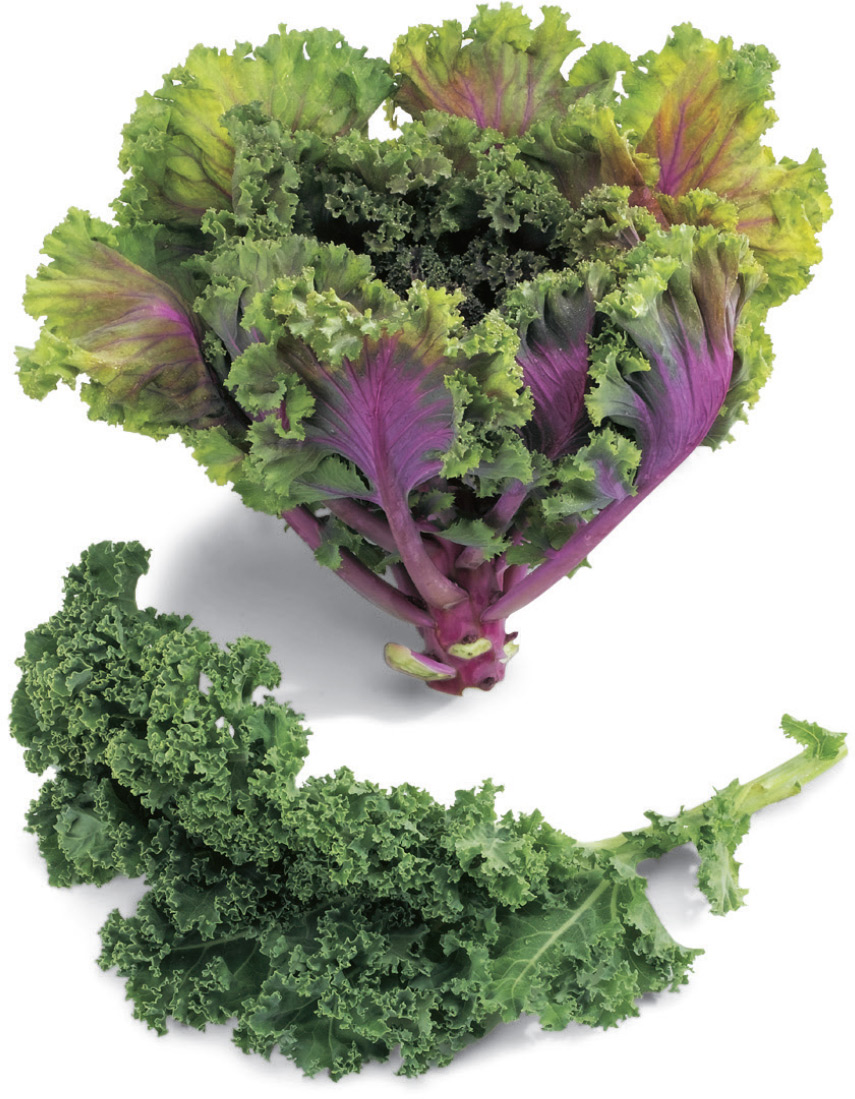
Kale is definitely a superstar vegetable. It’s a green, weird-looking leafy vegetable that is a form of cabbage. This vegetable is a nutritional powerhouse. And since the original publication of this book in 2007, the world seems to have caught on to kale’s amazing nutritional résumé. Kale has become the new superstar of the health-conscious crowd. A quick unscientific check on Google Shopping yielded at least a half a dozen brands of kale crisp snack foods, and kale is showing up on menus everywhere.
Why Kale Is Number One
When this book was first published, the USDA used a now-retired testing procedure to determine the antioxidant capacity of fruits and vegetables. The procedure looked at all the antioxidants and phytochemicals found in a plant food to determine how well everything worked together as a team—how much ability the “team” has to fight cell-damaging free radicals. The foods received an oxygen radical absorbance capacity, or ORAC, rating. Though there were different versions of the test, the best known had kale as number one among the vegetables, with an ORAC value of 1770. The next highest rated vegetable was spinach, with an ORAC value of 1260. Though the test isn’t used anymore, kale continues to score high rankings on nearly all the tests that have replaced it.
Prevent Cancer as You Chew
Because it’s a cabbage, kale has even more benefits than its antioxidant power alone would indicate. Like others in the Brassica family, it contains powerful phytochemicals like cancer-fighting indoles, plant compounds that have been found to have a protective effect against breast, cervical, and colon cancer. In addition, kale is high in sulfur and contains something called sulforaphane, which helps give a boost to the body’s detoxification enzymes and may help fight cancer as well. Sulforaphane is formed when the vegetables containing it are chopped or chewed, and it triggers the liver to remove free radicals and other chemicals that may cause DNA damage. In fact, a study in the Journal of Nutrition demonstrated that sulforaphane helps stop breast cancer proliferation.
Kale is also loaded with calcium, iron, and vitamins A, C, and K. It contains seven times the beta-carotene of broccoli and ten times as much lutein and zeaxanthin, carotenoids known to help protect against macular degeneration. And 2 cups (134 g) of the stuff contain about 4 g of protein and 3 g of fiber.
Secrets to a Great Kale Salad
Tender kale greens can provide a terrific addition to salads, especially when mixed with strong flavored ingredients such as tamari-roasted almonds or red pepper flakes.
Kale is one of my favorite foods. The Sherman Oaks (California) Whole Foods deli manager mixes kale leaves with pine nuts and cranberries, then softens the whole mixture by tossing it well in olive oil. It’s become so popular the deli can’t keep it in stock, and because of that recipe, I eat kale about five times a week. It’s amazing.
Kohlrabi
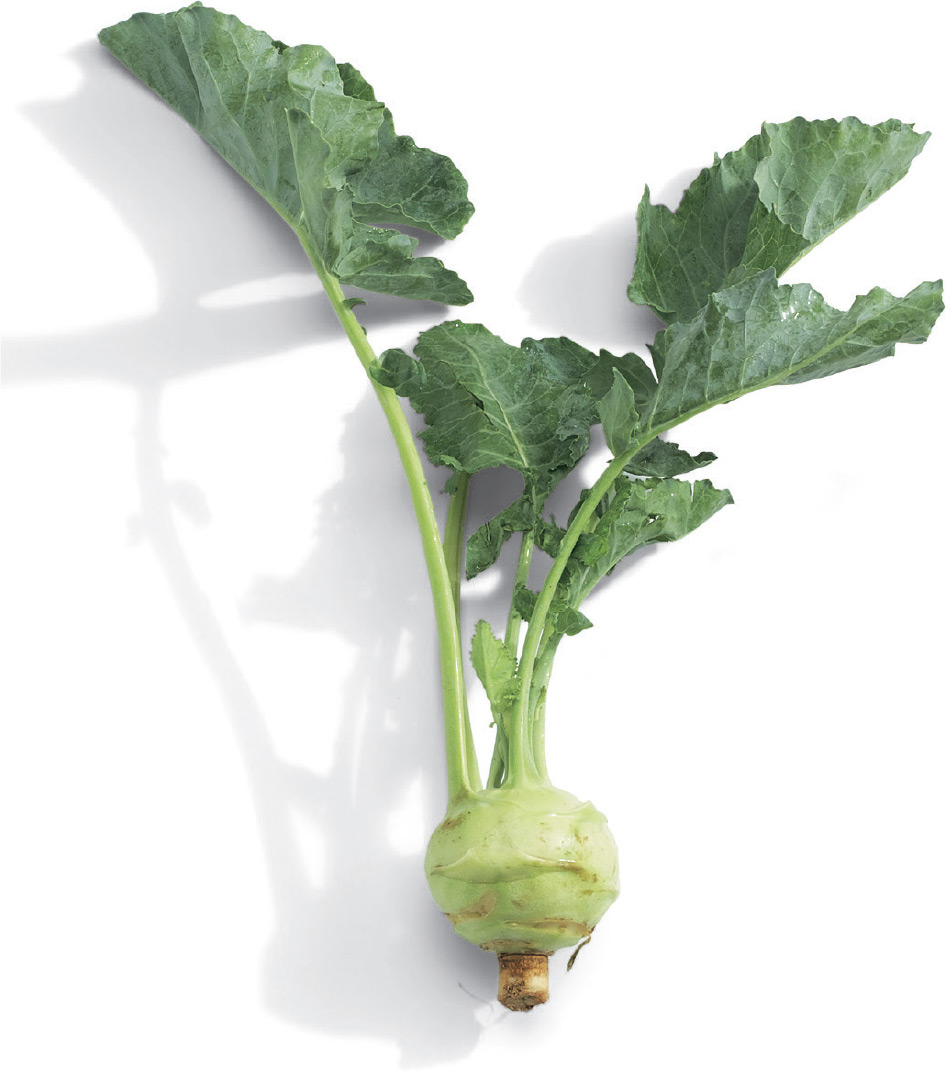
Kohlrabi is a member of the cabbage family, and it looks like a cross between an octopus and a space capsule. The name comes from the German kohl (cabbage) plus rabi (turnip) because of the resemblance of the cabbagelike stem to the turnip. The stem can be crisp and juicy, almost as sweet as an apple, and similar to a turnip in taste. You can eat it raw or cooked. It makes a great crudité. It comes in two “flavors,” green and purple, with the purple kind tending to be somewhat spicier. Both the leaves and the stem are edible.
Kohlrabi’s membership in the cabbage family of cruciferous vegetables gains it an automatic place among the world’s healthiest foods. Like its relatives (broccoli, Brussels sprouts, cabbage), kohlrabi contains important phytochemicals such as cancer-fighting indoles, sulforaphane, and isothiocynates. It’s also a good source of vitamin C (83 mg per cup [135 g]) and an excellent source of potassium (472 mg). And for a measly 36 calories per cup, you get a whopping 5 g of fiber.
In case someone ever asks you, Hamburg Township in Michigan has christened itself the “Kohlrabi Capital of the World.” No, I’m not making this up. At one time, back in the 1980s, they had a kohlrabi festival that drew six hundred people.
Leeks
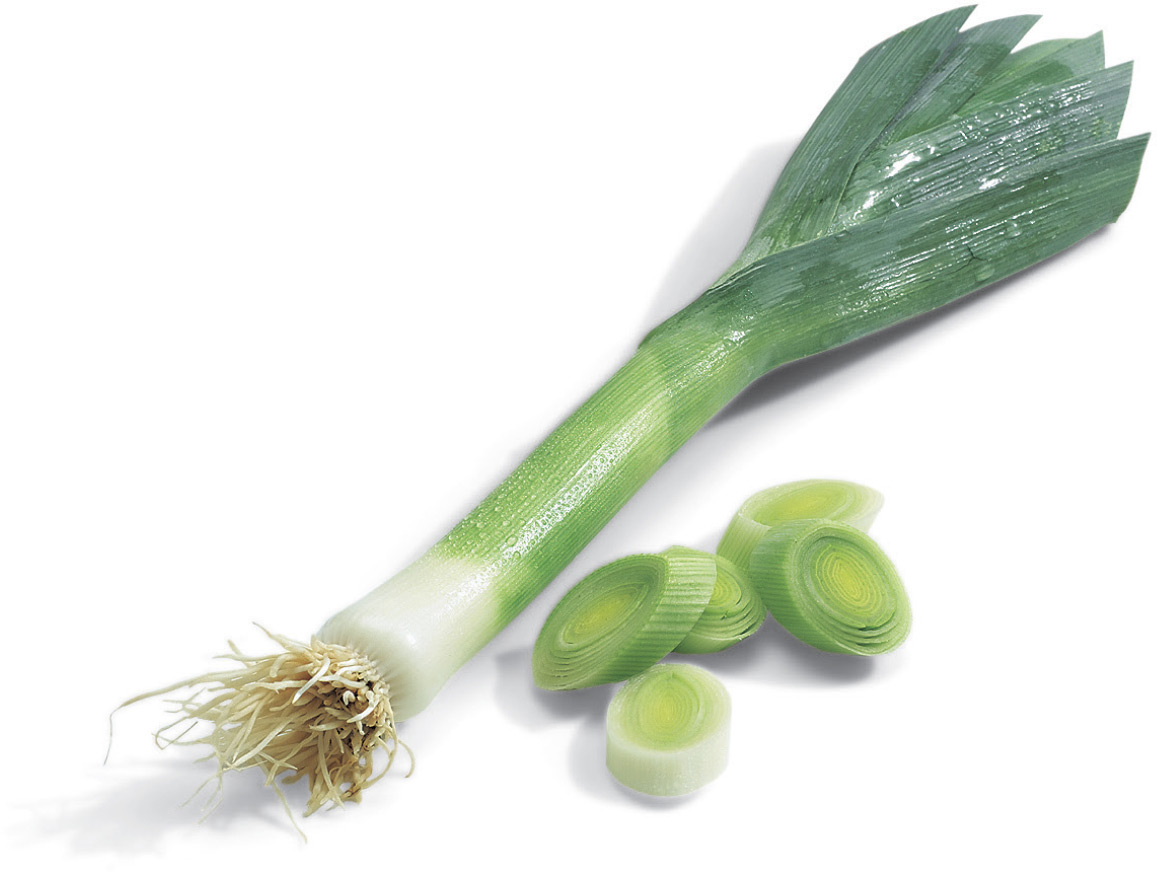
One way to think of a leek is as a sweeter version of an onion. They really are delicious, and most people add them to recipes like stir-fries for their marvelous flavor. But leeks have a serious side as well—they’re members of the allium family, which includes onions, garlic, and shallots. These vegetables contain a whole pharmacy of compounds with health benefits, including thiosulfinates, sulfides, sulfoxides, and other sulfur compounds.
The active substances in leeks, including allyl sulfides, help provide protection against cancers. Allyl sulfides block the action of hormones or chemical pathways within the body that promote cancer. Regular consumption of allium vegetables is associated with a reduced risk of both prostate and colon cancer. The sulfides of the allium family also decrease the tendency for blood clots to form—a significant risk for strokes and cardiovascular events. Plus, they lower levels of LDL (“bad”) cholesterol. Allium vegetables have also been shown to lower high blood pressure.
Good Down to the Roots
There is more to the leek than just the flavorful white bulb, which is the part most people use in cooking. Natural-foods expert Rebecca Wood uses the many tiny rootlets that hang from the base of the plant like little mop strings. She claims these mineral-dense filaments add valuable flavor and more nutrients and suggests cutting the cluster of stringy roots from the base, soaking them to loosen any embedded sand, rinsing, mincing, and sautéing in any vegetable dish or soup.
Leeks are also a good source of two of the most important carotenoids for eye health, lutein and zeaxanthin. One 54-calorie leek contains 1,691 mcg of these two superstar nutrients, which are currently the subject of extensive research for their ability to prevent macular degeneration, the number-one cause of blindness in adults. Leeks also have fiber, calcium, iron, magnesium, phosphorus, potassium, vitamin K, and more than 1,400 IUs of vitamin A.
 Maca
Maca

The first thing you need to know about maca is its nickname: Peruvian Viagra.
Okay, let that one sink in for a minute.
The reason they call it Peruvian Viagra is that it’s best known for its use in treating fatigue and sexual dysfunction. Research has shown that maca can be effective in improving both sexual desire and function. That alone makes it worth the price of admission.
But there’s a lot more.
Maca is one of those herbs that have been used in indigenous cultures (such as the ancient Incas) for thousands of years, mostly for its legendary ability to stimulate mental clarity and energy while enhancing sex drive. And although there’s a ton of anecdotal evidence of its benefits, there’s not a lot of Western science to prove its effectiveness.
Nonetheless, there’s great wisdom in the ancient cultures and, let’s face it, an herb doesn’t hang around for a couple thousand years and gain a solid reputation for being effective if it doesn’t work.
The late integrative and functional medicine psychiatrist Hyla Cass, M.D., said, “In my practice I have seen maca restore hormonal imbalance and related sexual desire and fertility in both men and women.”
My pal Chris Killiam, the Medicine Hunter, says, “The question is not whether it works—because we know it works with certainty—but how it works.”
Maca is considered an adaptogen, which is a class of compounds that act kind of like the thermostat in your house. When you set your thermostat at the ideal temperature, it will cool off the air if it’s too hot, and it will turn up the heat if it’s too cold.
That’s exactly how adaptogens work. They help you adapt to fluctuating levels, of, say stress hormones.
“Consuming maca often makes people feel more alive, energetic, and leaves them with a sense of well-being, all of which are thought to be due to its ability to restore proper hormone balance and elevate ‘feel good’ endorphins,” says noted health expert Josh Axe, D.N.M., D.C., C.N.S. Axe—a big fan of maca—points out that it provides over twenty amino acids, including eight essential ones, twenty free-form fatty acids (such as the antimicrobial lauric acid), vitamins B1, B2, C, and E, calcium, magnesium, and about nine other minerals. Maca is also a rich source of phytonutrients.
What’s more, maca stimulates the immune system. It’s antiviral, and may help to protect against the influenza virus. It’s believed to help women with Polycystic Ovary Syndrome (PCOS) by helping to control and balance estrogen levels. And a 2008 study showed that maca had positive effects on boosting mood and decreasing anxiety and depression in menopausal women. Maca root is a natural antioxidant, boosting your body’s levels of two of the most important antioxidants in the human body, glutathione and SOD (superoxide dismutase). It even lowers blood sugar.
And then, of course, there’s energy.
Energy is one of maca’s big selling points. Maca helps to regulate the hypothalamus, which in turn helps balance focus and energy. Many people feel better and brighter on a daily dose of maca—me included!
Personally, I start every single day with a maca drink. (This is separate from my protein drink, which I’ll often have after two hours on the tennis court.) I use Mighty Maca Plus, by Vida Pura, which was formulated by my good friend and colleague, Anna Cabeca, D.O., after years of research. I like it, number one, because it tastes good, and number two, because I trust Anna Cabeca, who is scrupulously conscientious in creating her products.
Mighty Maca Plus is a lot more than just maca, though. It’s also got spirulina, chlorella, mangosteen, a bunch of enzymes (such as bromelain and papain), oat bran, milk thistle, resveratrol, quercetin, flaxseed, turmeric, grape seed extract, and green tea extract, making it one of the most complete green drinks I’ve ever come across.
I use one or two heaping scoops a day, and I mix it in the NutriBullet with pomegranate juice, some powdered brain formula, five or six drops of liquid vitamin D, my Oligo30 prebiotics, a packet of ResVitále Collagen Renew, and a squirt of Omega Swirl by Barlean’s, in either key lime or mango peach.
Consuming it is a great way to start the day. You can order Mighty Maca Plus on my website, www.jonnybowden.com.
I’m sure you’re going to love it as much as I do.
 Mushrooms
Mushrooms
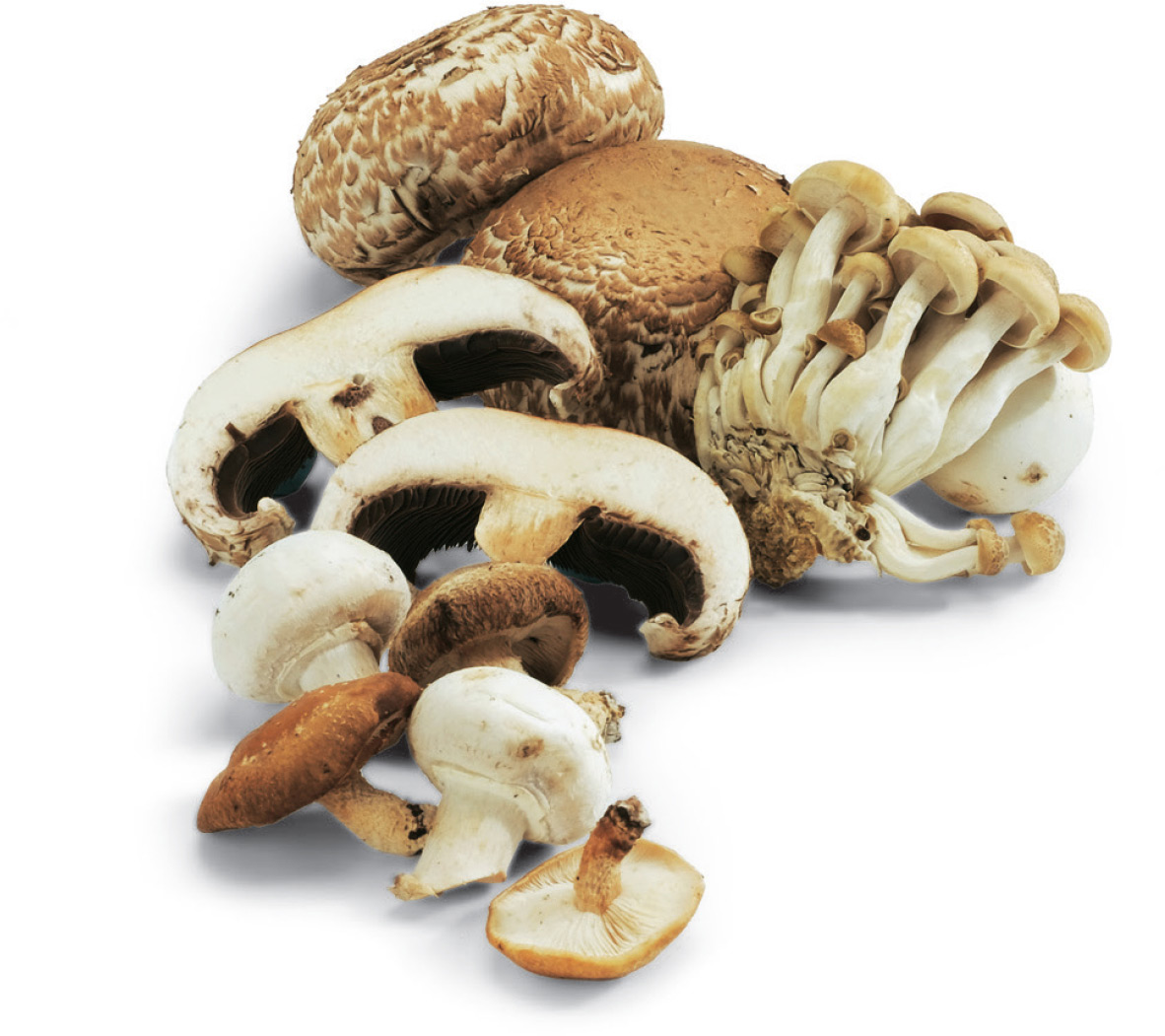
Although mushrooms have been used medicinally in Eastern medicine for eons, Western medicine is now beginning to catch up as the healing properties of mushrooms are beginning to be demonstrated scientifically. Medicinal mushrooms contain potent antiviral, anti-inflammatory, antimicrobial, and antibacterial compounds. Some of the polysaccharides found in medicinal mushrooms activate cytokines and natural killer cells, which in turn latch onto cancer cells, causing them to die. They also possess anticancer and immune system enhancing capabilities.
The three specific types with the greatest health benefits are maitake, shiitake, and reishi. All three have powerful effects on the immune system, and all three act as medicine. Ganoderma, turkey tail, and chaga mushrooms have also been used medicinally.
When you think about it for a minute, it makes an awful lot of sense that mushrooms have medicinal properties. Mushrooms are fungus. They scavenge on organic matter. Where do you find them? Growing on decaying matter, such as wood. That means they can absorb—and then safely eliminate—toxins. I don’t know about you, but I’d like to put them to work doing that in my own body, and eating them appears to be a great way to do it.
Maitake
Maitake comes from the Japanese word meaning “dancing mushrooms”—an urban legend says foragers danced with joy when they found it. According to some legends, the little mushroom could be traded for its weight in precious metals.
In addition to being loaded with vitamins, maitake has a special polysaccharide component called beta-1,6 glucan, a very close relative of the beta-1,3 glucan in the shiitake (see below). Beta-glucans stimulate the immune system. Many of the compounds in the cell structures of mushrooms are classified as HDPs—host defenses potentiators. They’re used as adjunctive cancer treatments throughout Asia. In fact, Maitake is approved by the Japanese government for just this purpose.
Maitake is especially good for counteracting the toxic effects of radiation and chemotherapy, such as extreme fatigue and nausea. Maitake extract can shrink tumors in mice, my friend Robert Roundtree, M.D., author of Immunotics, says. He also points out that several studies in Japan showed that maitake and chemotherapy together can boost the effectiveness of standard chemotherapy for several types of cancer. He personally feels that maitake is the most potent of the three medicinal mushrooms discussed here, though he uses all of them for different things.
Shiitake
The shiitake mushroom is one of the most widely cultivated specialty species of mushroom in the world and is deeply valued for its medicinal effects as well as for the fact that it tastes delicious. It contains enzymes and vitamins that do not normally appear in plants, such as all eight essential amino acids and one of the essential fatty acids, linoleic acid. The caps contain more nutrients than the stems.
This superstar mushroom contains a chemical component especially worth noting: lentinan, which is approved as an injectable drug in Japan and usually used to prolong survival of patients in cancer therapy. It doesn’t work directly against cancer, but it is believed to help prevent some of the damage that results from anticancer drugs.
Lentinan is also referred to as beta-1,3 glucan, a polysaccharide that has potent immune-stimulating effects, and a close relative of the beta-1,6 glucan found in maitake (see above). When beta-glucans bind to immune system cells like natural killer (NK) cells, T-cells, and macrophages, the activity of these cells is increased. No one is quite sure why, but Roundtree speculates that the beta-glucans trick immune system cells into thinking they’re under attack. (Mushrooms are, after all, fungus, and maybe the cells think the harmless little critters are dangerous. Who knows? The point is, the immune system is stimulated by them.) Many studies have confirmed beta-glucans’ wide range of protective effects, including improved resistance to infections, liver protection, and cardiovascular benefits. It also appears to help inhibit tumor growth in mice.
Japanese researchers have reported that consumption of shiitake mushrooms lowers blood cholesterol by as much as 45 percent, due to an active compound in them called eritadenine.
Reishi
Sometime in the third century BCE, the Chinese emperor Shih Huang was reputed to have sent a fleet of ships to search for a mushroom called the “Elixir of Immortality.” That mushroom? The reishi. Its special chemical makeup was thought to be a tonic for a long and healthy life. In traditional Chinese medicine, reishi is still considered to be among the highest class of tonics.
Now we’re finding out that they may have been on to something. One study at Cornell Medical College found that reishi reduced side effects during chemotherapy while improving the quality of life. Its beneficial components—specifically ganodermic acids classified as triterpenoids, plus a number of polysaccharides—seem to benefit everything from blood pressure to liver detoxification to adrenal function.
REISHI HAS EARNED ITS CANCER-FIGHTING REPUTATION
Even the conservative and highly regarded Memorial Sloan Kettering Cancer Center has reishi mushroom listed on the “about herbs” section of its website, where it states that reishi mushrooms stimulate the immune system through their positive effect on macrophages and other immune compounds. Sloan Kettering also references clinical studies showing that reishi increases antioxidant capacity and enhances the immune responses in advanced-stage cancer patients.
And then there’s stress.
Reishi mushrooms appear to be a natural stressbuster. Reishi is the mushroom of choice for people under extreme physical or emotional stress, Roundtree says. He recommends it for endurance athletes as well. Reishi mushrooms have a high level of antioxidants, largely due to their ganodermic acid.
Cremini (white button mushrooms)
I almost omitted cremini mushrooms from the list completely—I mean, after all, how could these little prosaic mushrooms possibly hold a candle to the downright medicinal value of their famous siblings? But, my friend, traditional naturopath Regina Wilshire, sent me this missive, just in time for press. It’s so complete, I’m going to reprint it right here in its entirety:
“Cremini mushrooms are superdense with nutrients. One 5-ounce serving (dry weight before cooking) gives you more than 50 percent of the Daily Value for the cancer-fighting trace mineral selenium, 40 percent of the Daily Value for riboflavin, 35 percent of copper, 30 percent of niacin, 20 to 25 percent of pantothenic acid, phosphorus, and zinc, plus 10 to 15 percent Daily Value of manganese and thiamin. They also have trace amounts of magnesium, calcium, folate, B12, and iron.”
Now I don’t feel so bad counting mushrooms as a vegetable!
The Mushroom Weight Loss Plan?
Mushrooms in general also contain a powerful antioxidant called L-ergothioneine. L-ergothioneine neutralizes dangerous free radicals called hydroxyl radicals and increases enzymes with antioxidant activity. In at least two studies, it seems to act as a metabolic energy enhancer, stimulating the breakdown of sugar in red blood cells and mimicking carnitine in its ability to transport fat into the mitochondria of the cells where the fat can be burned for energy. That’s exactly what most over-the-counter weight loss supplements promise but rarely deliver.
Three studies also showed L-ergothioneine to be a protector of environmental UV-radiation damage. Though shiitake and maitake have much more of it, even our friend the lowly white button mushroom has many times more L-ergothioneine than wheat germ and chicken liver, the other two sources of this incredible antioxidant.
Okra
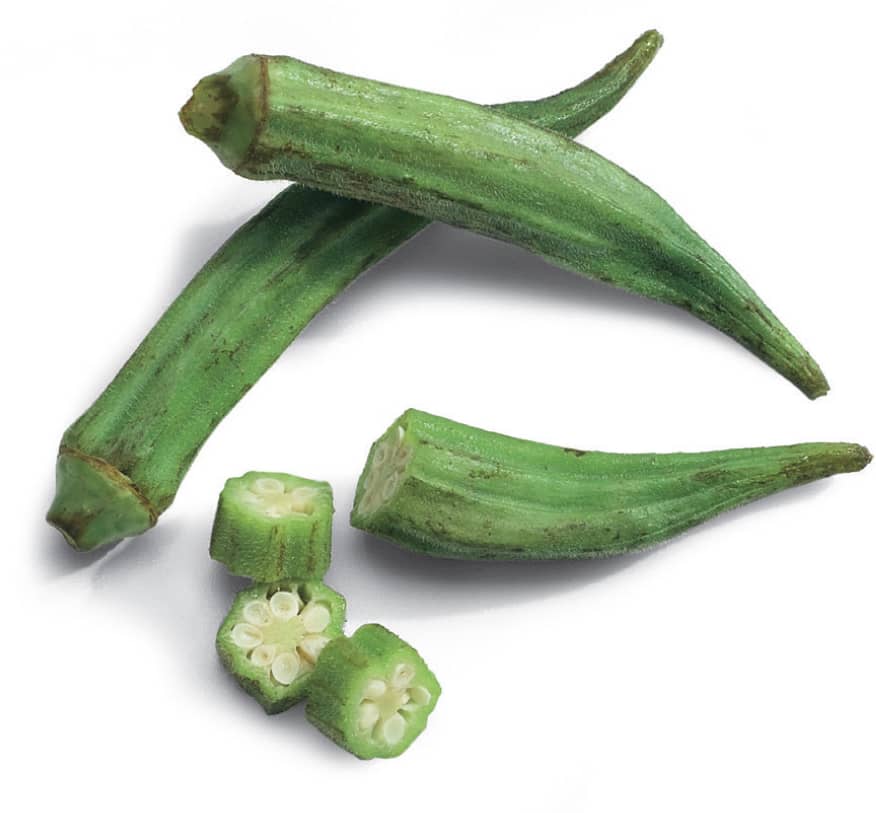
For generations, okra has been a staple of traditional Southern cooking. This nutritious green vegetable arrived in the United States in the mid-1600s and became an important part of the colonial diet. Its seeds were even used to brew a coffee substitute that was consumed by Southern Americans during the Civil War, when they couldn’t obtain coffee beans. Today it’s still very much a part of what is lovingly called “soul food.”
Okra contains a unique combination of valuable nutrients. It’s one of a select group of foods that include naturally occurring glutathione, arguably the most important antioxidant in the body. Optimal amounts of glutathione are necessary for supporting the immune system; glutathione is required for replication of the lymphocyte immune cells. It also helps the liver detoxify chemicals.
Okra Beats Cereal for Fiber Content
Okra’s also a high-fiber food. People often ask me where they should get their fiber from, given that our standard diet is so deficient in this important compound. My standard answer is fruits, vegetables, and legumes, and okra is a perfect example of what I’m talking about. One cup (160 g) of cooked okra—which is a tiny 35 calories’ worth—provides 4 g of fiber, way more than the average slice of bread or the average cup of commercial cold cereal. And for a vegetable, it’s also high in protein. That same 35-calorie cup also provides almost 3 g of protein.
Calorie for calorie, okra is high in calcium, magnesium, potassium, vitamin A, vitamin K, and folic acid, which helps prevent neural tube defects in developing fetuses. In Ayurvedic medicine, okra is considered tridoshic, meaning it is good for balancing all metabolic types. It can be steamed, pickled, broiled, baked, or even fried and goes well with tomatoes and highly seasoned vegetable dishes. When you boil it, it gives off a kind of viscous substance that adds a lot of smooth thickness to soups and stews, making okra a favorite for gumbo.
Note: The larger pods are tough and fibrous. Look for smooth, firm, unblemished, brightly colored pods smaller than 3 inches long.
 Onions
Onions

There are no two ways about it: Onions are a cancer-fighting food. In several impressive published studies, the consumption of onions (and other members of the allium vegetable family) demonstrated protective effects against stomach cancer. And in one study published in the Journal of the National Cancer Institute, eating onions (as well as other members of its family such as garlic, scallions, chives, and leeks) significantly lowered the risk for prostate cancer. Onions (and their close relatives) have also been shown to have the same effect against esophageal cancer.
In Vidalia, Georgia, where the Vidalia onion comes from and where onions are consumed in large quantities, the death rate from stomach cancer is 50 percent lower than the national mortality rate from stomach cancer. One theory is that onions contain diallyl sulfide, which increases the body’s production of an important cancer-fighting enzyme, glutathione-S-transferase.
Onions Help Build Strong Bones
At least two important studies show that onions help build strong bones. In one, published in the prestigious journal Nature, male rats fed a small amount of dried onion daily had a 17 percent increase in calcium; female rats that had had their ovaries removed (which would rapidly induce bone loss and osteoporosis) had stronger bones when fed onions. And in another study, published in the Journal of Agriculture and Food Chemistry, a compound in onions inhibited the activity of the cells (osteoclasts) that break down bones. The popular drug Fosamax works in a similar way, but onions have no side effects, unless you count the need to have a breath mint before kissing someone!
Onions belong to the allium family, which also includes leeks, garlic, and shallots. They contain a whole pharmacy of compounds with health benefits, including thiosulfinates, sulfides, sulfoxides, and other smelly sulfur compounds. But those same smelly compounds offer a lot of nutrition bang for the relatively small price of a little eye-watering. In a study in the European Journal of Clinical Nutrition, onions are one of a very select group of foods that in combination reduced mortality from coronary heart disease by an impressive 20 percent. The others included broccoli, tea, and apples.
Why Allergy and Asthma Sufferers Benefit from Onions
Onions contain powerful antioxidants, and they are anti-inflammatory, antibiotic, and antiviral. They are a great source of quercetin, one of my favorite anti-inflammatory compounds and one that is associated with beneficial effects on chronic diseases like cancer and heart disease. The class of chemicals that quercetin belongs to—flavonoids—have antiallergic properties as well. Quercetin is frequently used by nutritionists as part of their arsenal for treating allergies with natural substances. It can help relieve asthma and hay fever by blocking some of the inflammatory responses in the airways. Our bodies absorb quercetin from onions very easily, though you’ll probably need quercetin supplements if your main interest is using it therapeutically as an anti-inflammatory. Onions also contain several sulfides similar to those in garlic, which may lower blood lipids and blood pressure.
The type of onion affects the content of the health-promoting chemicals, and the stronger-tasting ones have superior properties.
Peppers
Hot peppers: cayenne, chile, jalapeño

You would think that hot peppers—such as chile peppers or cayenne peppers—would be exactly what you’d want to avoid if you had heartburn. Maybe, maybe not. At least one study demonstrated that the active ingredient in hot peppers may protect the stomach lining from damage. Granted, that study was done in rats, but still. The active ingredient—capsaicin—has a host of benefits and uses.
Capsaicin peppers are rich in a host of nutrients, including beta-carotene, eye-friendly carotenoids lutein and zeaxanthin, and vitamin C. Their vitamin C content is probably the reason they have been used as a popular natural remedy for colds and coughs.
Hot peppers also may make you feel good. Capsaicin interacts in the body with a protein called TRPV1, which normally gets “turned on” by physical heat. That causes a chain reaction in which messages get sent to the brain (“we’re on fire!”). One of the substances released during this chain reaction is called Substance P, which basically transmits pain signals to the brain.
When those pain signals are received, the brain responds by releasing endorphins, a class of neurotransmitters that makes you feel good. Endorphins are thought to be responsible for the euphoric sensation known as “runner’s high.” And that’s why eating capsaicin peppers can make you feel good.
One of the neurotransmitters released in response to substance P is dopamine, the neurotransmitter of excitement and anticipation. This is why peppers can sometimes give you a pick-up, and is probably what Hillary Clinton was talking about when she told the New York Times (back in 2008) that she got a lot of energy from eating them.
Peppers for Pain Relief?
That same active ingredient, capsaicin, produces a feeling of warmth when applied to the skin, and it is used a lot in pain-relieving creams. Capsaicin is a vasodilator, which enhances circulation and increases body temperature. Hot peppers, and their respective powders, may act as a metabolism booster. In one study on mice, the active ingredient promoted energy metabolism and suppressed body fat accumulation. Makes sense when you think of how eating hot peppers makes you sweat.
Traditionally, some hot peppers such as cayenne were used to aid digestion and stimulate the appetite. Counterintuitive though it seems, they probably do not irritate the stomach. In fact, they may help prevent ulcers by killing bacteria, and they also simulate the lining of the stomach to secrete powerful protective juices. In Ayurvedic medicine, they are used for healing, but with care. They’re definitely not recommended for anyone with an inflamed colon.
Red chiles have a nice amount of vitamin A, and both red and green chiles contain fiber, potassium, folic acid, and iron. Some people with sensitive skin are warned to wear rubber gloves when handling them. In general, the smaller and more pointed the pepper, the hotter the taste.
Sweet Peppers
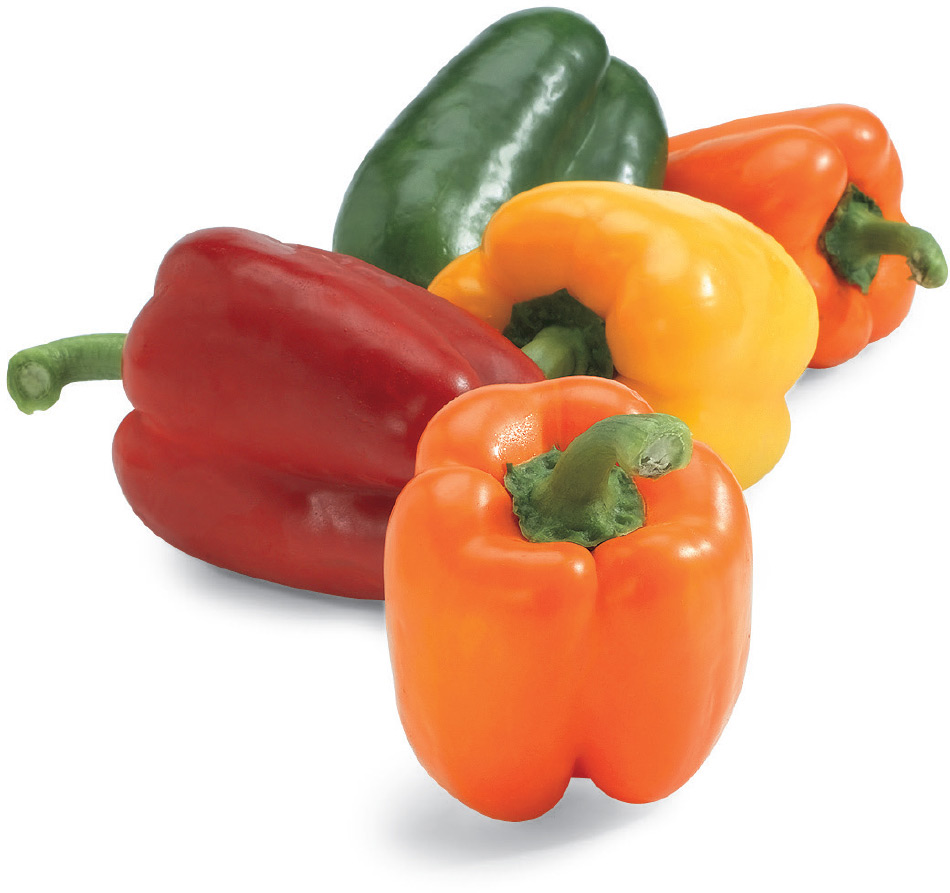
On Saturdays in the summertime you can walk around the city—at least in Los Angeles and New York, which are the only two cities I’ve lived in—and see gorgeous mountainous displays of fresh vegetables at the local farmers’ market. If you look closer, you’ll usually find that the vibrant colors that catch your attention are brought to you courtesy of the peppers.
They come in a wide variety of shapes and colors, with yellow, red, orange, and green being the most common, though I’ve seen some nice-looking purple ones around as well. If you look carefully, you may even be able to spot a rarer black variety.
The Sweet and Spicy Difference
Both chile peppers and sweet peppers belong to the capsicum family, which is Latin for “box.” The major difference between the two is that chiles contain fiery capsaicin (see hot peppers, 58-59) and are used mainly as a spice. The sweet ones lack capsaicin and are mainly used as vegetables. The riper the pepper, the greater its nutrition and the better its flavor. In general, the thinner the skin the more peppery the taste; the thick-skinned ones are sweeter. Many peppers start life as a green vegetable and, when they fully mature, they change colors. Red is the sweetest of the bell peppers; it is a fully ripened green pepper with a milder flavor.
Peppers are low in calories and a well-kept secret as a snack food. They blend with everything. I’ve eaten them raw like an apple, or combined them with some string cheese. They’re also good sliced up with some buffalo mozzarella and extra-virgin olive oil. And they’re great in salads and in stir-fries.
Nutritionally, peppers are an excellent source of vitamins C and A (beta-carotene) and the mineral potassium. They also contain vitamin K, which is increasingly being recognized as a vitally important component of bone health. Peppers are also one of the few foods around that contain lycopene, a member of the carotenoid family that has been shown in quite a bit of research to be associated with lower risk of prostate cancer. The amount of lycopene in the average pepper isn’t substantial, but it’s more than in most foods, and every little bit helps.
Though early studies using supplemental beta-carotene with smokers did not turn out the way we had hoped, the natural vitamin A and other compounds in peppers are, in fact, turning out to be protective. Red peppers contain beta-cryptoxanthin, a carotenoid that may lower the risk of developing lung cancer. One study, in Cancer Epidemiology Biomarkers and Prevention, followed more than 63,000 people in China and found that those eating the most cryptoxanthin-rich foods had a 27 percent lower risk for lung cancer. And some research indicates that exposure to a carcinogen in cigarettes—either directly or secondhand—induces a vitamin A deficiency, so foods rich in vitamin A may help counter that and provide some level of protection. Vitamin A is also a great immune system stimulator.
The Dark Side of Peppers
Now here’s the dark side, which really isn’t all that dark. Peppers are a member of the nightshade family along with eggplants and tomatoes. Nightshades are high in alkaloids, chemical substances that can have a strong physiological effect. In fact, many (but not all) alkaloids are frequently found in drugs: coffee, opium, morphine, heroin, belladonna. That said, mature fruits such as eggplants, tomatoes, and peppers contain only faint traces: you won’t get stoned from eating peppers! And cooking lowers alkaloid content by almost half. Nonetheless, one substance in nightshades—solanine—may have an impact on those with arthritis, and many arthritics are told to follow a “no-nightshade” diet. There isn’t really any strong research evidence to back this up, but there are many folks walking around whose symptoms have improved when they eliminated nightshades. Norman Childers, Ph.D., the chairman of the Arthritis Nightshades Research Foundation, has theorized that some people with osteoarthritis may not be able to destroy solanine in the gut.
Pumpkin

We tend to think of pumpkins only at Thanksgiving and Halloween, but it’s time to ditch that limited view of this great vegetable and expand its portfolio. Pumpkin is an unheralded superfood—it’s ridiculously low in calories while high in nutrients.
For example, pumpkin is a potassium heavyweight—for a measly 49 calories per cup (245 g) of mashed pumpkin, you get a whopping 564 mg of potassium, that’s about 33 percent more than a medium banana.
Why should you care? Because the balance between potassium and sodium is of critical importance to our health. Potassium works with sodium to maintain the body’s water balance, and that in turn affects all sorts of important things—such as blood pressure, for example.
One possible explanation for potassium’s protective effect against hypertension is that increased potassium may increase the amount of sodium excreted from the body. Several studies indicate that people who consume high amounts of potassium have lower blood pressure than people who don’t. In primitive cultures, salt intake is about seven times lower than potassium intake, but in Western industrialized cultures, salt intake is about three times higher than potassium intake.
Can Pumpkins Decrease Your Risk of Stroke?
Consider this: Several large epidemiological studies have suggested that increased potassium intake is associated with decreased risk of stroke. A study of more than 43,000 men followed for 87 years found that men in the top 20 percent of potassium intake (averaging 4,300 mg per day) were only 62 percent as likely to have a stroke than those in the lowest 20 percent of potassium intake (averaging 2,400 mg per day). This inverse association was especially high in men with high blood pressure.
Four large studies have reported significant positive associations between dietary potassium intake and bone mineral density. This isn’t surprising if you think about it. When we eat a highly acid diet, the body has to buffer that acid, and it does this by mobilizing alkaline calcium salts from the bones to neutralize the acids consumed in the diet. Increased consumption of high-potassium fruits and vegetables, such as pumpkin, reduces the net acid content of the diet and may help preserve calcium in the bones, where it belongs.
The Choice of Champions
Finally, athletes may need more potassium to replace what is lost from muscle during exercise and the smaller amount lost in sweat. Low potassium can cause muscle cramping and cardiovascular irregularities. When clients tell me they have muscle cramps, the first thing I think is that they’re low on minerals, especially potassium, magnesium, and calcium.
Pumpkin would be a great food just on the basis of its high amount of potassium. But there’s much more to pumpkin than potassium. One cup (245 g) of mashed pumpkin contains more than 5,000 mcg of beta-carotene, another 853 of alpha-carotene, and more than 3,500 mcg of beta-cryptoxanthin, a member of the carotenoid family that seems to reduce the risk of lung and colon cancer. Studies have shown that beta-cryptoxanthin can reduce the risk of lung cancer by more than 30 percent. Other studies have shown that it reduces the risk for rheumatoid arthritis as well (by 41 percent in one study). It appears to have strong antioxidant properties.
Your Eyes Will Thank You
Pumpkin has more than 2,400 mcg of the carotenoids lutein and zeaxanthin, which are fast becoming the star nutrients in eye health and vision protection programs. Pumpkin also has more than 12,000 IUs of vitamin A, plus a little bit of calcium, iron, magnesium, and phosphorus just for good measure. And a cup (245 g) of the stuff also provides more than 21/2 g of fiber.
Remember that the carotenoids need fat for absorption, which makes it all the easier to consume some pumpkin on a regular basis. Just cook it with a dab of butter or olive oil. If you like it sweet, try adding some xylitol. It’s an extraordinary substitute for mashed white potatoes; way healthier, and in my opinion, way more delicious.
The Fiber Connection
For decades, I’ve railed against the conventional wisdom that grains are an important source of fiber. They’re not—just read the label on any cereal box. Pumpkin, however, is a whole different story. Consider that the average slice of bread or the average portion of commercial cold cereal has between 1 to 3 g of fiber, and it comes with a whole host of blood-sugar-raising starch, not to mention gluten and (frequently) high-fructose corn syrup. Pumpkin, on the other hand, has 49 calories per cup (245 g), and a whopping 7 g of fiber. Bread is about 100 calories a slice, and, with few exceptions, has virtually nothing of nutritional value to recommend it. And no bread on Earth provides the amount of fiber that a cup of mashed pumpkin provides.
In case you think this doesn’t matter, consider that just about every epidemiological study ever done shows much better health outcomes for people who consume large amounts of fiber in their diet. Since the publication of this book, Steven Masley, M.D., and I presented a study at the annual conference of the American College of Nutrition showing that fiber intake was one of the best predictors of success on a weight loss program. Fiber matters—it slows the entrance of sugar into the bloodstream (blunting its glycemic impact), helps with digestion, and provides “food” for bacteria in the gut. When bacteria in the gut dine on fiber, they produce critically important nutrients such as butyric acid, which helps support the integrity of the gut wall and may have positive metabolic effects as well. Adding a cup (245 g) of pumpkin to your daily intake is a great way to get about 20 to 25 percent of the fiber you should be getting daily.
Purslane

If you Google purslane, you’ll find all kinds of agricultural sites that tell farmers how to get rid of it because many people confuse it with a weed. It’s an incredibly nutritious vegetable that is valued in Asia and Europe both as a pot herb and as a medicinal one. Though it comes from India, where it was a food crop centuries ago, it now grows wild all across America. Henry Thoreau, in his book Walden; Or, Life in the Woods, mentions that he made “a satisfactory dinner of a dish of purslane” that he gathered and boiled.
Purslane Highest in Omega-3s
The real claim to fame of purslane as a health food is that its omega-3 concentration is the highest of any green leafy vegetable. About one cup (100 g) of fresh purslane leaves can contain up to 300 to 400 mg of alpha-linolenic acid, the same omega-3 found in flaxseed. Purslane also contains small amounts of the longer-chain omega-3s (DHA and EPA), which are rarely found in anything but fish and fish oil. Omega-3 fatty acids are anti-inflammatory, heart-healthy fats that have been found beneficial in hypertension, type 2 diabetes, coronary heart disease, and depression. The more omega-3s we eat, the better! (Note: For more on the benefits of omega-3 fats, see here.)
Purslane has plenty of other nutrients besides its omega-3 content. In fact, Artemis Simopoulos, M.D., author of The Omega Plan, devoted an entire article in the Journal of the American College of Nutrition to the health benefits of this vegetable (“Common purslane: A source of omega-3 fatty acids and antioxidants”). One cup (115 g) of the cooked leaves contains 90 mg of calcium, 561 mg of potassium, and more than 2,000 IUs of vitamin A.
Purslane leaves and stems are great raw in salads, but they can also be steamed or added to soups, stews, and vegetable dishes. You’ll frequently see it in health food stores as part of mesclun salad. It’s got a mild, sweet-and-sour flavor and a chewy texture.
 Spinach
Spinach

Calorie for calorie, green leafy vegetables such as spinach provide more nutrients than almost any other food on the planet. Spinach is loaded with vitamins, and it is one of the best sources of vitamin K. Vitamin K is critically important for building strong bones; it activates a compound called osteocalcin that anchors calcium molecules inside the bone. In the ten years since the original publication of this book, vitamin K (particularly K2) has taken its rightful place as one of the most important nutrients we can consume.
So see, you can take all the calcium you want, but if it’s not getting into the bones, it’s not going to do you very much good, and it can do you some harm by being deposited in other places in the body, like the arteries. I believe this is a big part of the reason why studies have shown increases in heart disease with people taking large doses of calcium, the way we’ve been advised to for years. That calcium doesn’t do you any good if it winds up in the arteries instead of the bones, and in the absence of vitamin K, that’s exactly what happens. Vitamin K (especially K2) makes sure that you get the minerals into the bone where they belong. And 1 cup (30 g) of fresh spinach leaves provides 200 percent of the Daily Value of vitamin K.
Worth noting: Most of the vitamin K found in green leafy vegetables such as spinach is in fact vitamin K1. Vitamin K2, on the other hand, is found mainly in fermented foods. While vitamin K2 is important for heart health (probably by keeping calcium out of the arteries), vitamin K1 is still critically important for bone health, so don’t make the mistake of dismissing its importance just because of all the buzz about K2.
Great Alternative to Milk for Vitamin C
Speaking of calcium, spinach is a fine source, and it is a great alternative to dairy for people who don’t want to drink milk. It’s also got vitamin A, manganese, folic acid, magnesium, iron, vitamin C, and the powerful anti-inflammatory compound quercetin.
Researchers have identified at least thirteen different compounds in spinach—they’re called flavonoids—that function both as antioxidants and as anticancer agents. The anticancer properties of these compounds in spinach have been so impressive that researchers have created specialized spinach extracts that could be used in controlled studies. These extracts have been shown to slow down cell division in stomach cancer cells and, in studies on mice, have been shown to reduce skin cancers. And one study on adult women living in New England in the late 1980s showed that the more spinach women ate, the less the incidence of breast cancer. Powerful stuff, right?
Popeye Had It Right
For men, a carotenoid in spinach fights prostate cancer in two different ways. Research published in the September 2004 issue of the prestigious Journal of Nutrition showed that this spinach compound—it’s called neoxanthin—causes prostate cancer cells to self-destruct. It also helps prevent their replication. That alone is a pretty good reason to make like Popeye.
Spinach is a great source of vitamin C and vitamin A, which are vitally important antioxidants that help prevent cholesterol from becoming oxidized. Oxidized cholesterol is the only kind of cholesterol you need to worry about (see The Great Cholesterol Myth by Stephen Sinatra and myself). Oxidized cholesterol is damaged cholesterol, the kind that goes hand in hand with inflammation and ultimately contributes to heart disease. Getting plenty of vitamin C and beta-carotene can help prevent this.
One cup (180 g) of boiled spinach gives you an awesome 294 percent of the Daily Value for vitamin A. It’s also a great source of folic acid, which helps bring down a dangerous chemical in the body called homocysteine, which is harmful to blood vessels and puts you at risk for heart disease, stroke, and dementia. And spinach is also loaded with magnesium, a mineral that helps lower high blood pressure and protect against heart disease at the same time. When given to rats, spinach produced a blood pressure–lowering effect within just two to four hours. And to get that effect, the rats only had to eat the human equivalent of one main course–sized spinach salad for lunch or one side serving of steamed spinach.
Sharp Minds for Spinach Eaters
Spinach can also help prevent colon cancer because its vitamin C and beta-carotene help protect the colon cells from the damaging effects of free radicals. Those vitamins also help reduce inflammation, and they may help protect the brain from the kinds of age-related declines we often see in brain function. In fact, one study in the May 2005 issue of the Journal of Experimental Neurology showed that rats fed diets enriched with spinach and blueberries lost a lot fewer brain cells after a stroke and recovered significantly more than rats that weren’t eating the spinach and blueberry-enriched diets. To get these protective benefits, the rats in the experiment only had to eat a measly 2 percent of their diet as spinach and blueberries!
Spinach is a great source of iron. That’s especially important for menstruating women, who are a lot more at risk for iron deficiency. Sure, the iron in vegetables isn’t as potent and absorbable as the heme iron (found in animal foods), but it still counts!
Finally, spinach contains lutein, a carotenoid that protects against eye disease and vision loss, like the kind caused by cataracts and macular degeneration. Now here’s something interesting: Lutein can’t be absorbed unless fat is also present. (That’s why the lutein in egg yolks is so powerful.) So, to really get the vision protection that the lutein in spinach has to offer, I suggest enjoying your spinach steamed, sautéed, or fresh in a salad with a little olive oil and a topping of chopped hard-boiled eggs. One of my favorite ways to eat it is to stir-fry it in coconut oil. Even if you think you hate spinach, you’ll find that way of preparing it to be delicious! And spinach is one of the lowest-calorie foods on the planet. You’d have to eat barrels of the stuff to equal the calories in even one small serving of french fries.
Squash (winter and summer)

Squash comes in two basic categories: winter and summer. While they share characteristics, there are significant differences. Summer squash comes in several different varieties, including zucchini, crookneck, and pattypan. It was first cultivated for its seeds; the squash of 10,000 years ago didn’t have much flesh, was bitter and inedible, and didn’t bear any resemblance to the squash we see in supermarkets today. The more modern version started as a wild squash in South America, spread throughout the Americas, and was brought back to Europe by old Christopher Columbus himself. Now it’s produced around the world.
Summer and Winter Squash Go Head to Head
Like most vegetables, summer squash is high in the heart-healthy mineral potassium. One cup (180 g) of cooked summer squash gives you more than three times the amount of potassium in the typical potassium supplement. There’s also a decent amount of vitamin A, and beta-carotene, and best of all, more than 4,000 mcg of lutein and zeaxanthin, two members of the carotenoid family that are getting serious research attention for their ability to protect the eyes against macular degeneration and other vision problems.
Winter squash comes in many varieties also, the most well known being acorn squash, butternut squash, and spaghetti squash. Pumpkin is technically in this category also, but gets its own listing because of its many specific benefits. Winter squash is higher in carbohydrate content than summer squash, and there are some specific differences among the winter varieties. Acorn squash is a fiber heavyweight—1 cup (245 g) of cooked acorn squash gives you 9 g of fiber, which makes it one of the highest-fiber foods in this book, especially calorie for calorie (1 cup of acorn has 115 calories). It also has a whopping 896 mg of potassium and almost 2 mg of iron. Spaghetti squash, on the other hand, has almost no calories (42 calories per cup [155 g]!) but also less fiber (2.2. mg) and a lot less potassium and vitamin A.
Butternut squash is a vitamin A giant, weighing in at a whopping 22,868 IUs per cup (240 g). Butternut is also high in both beta-carotene and its less well-known brother, alpha-carotene, which has many health benefits of its own. And butternut is unique among the squashes in that it has a substantial amount of beta-cryptoxanthin, a carotenoid that may lower the risk of developing lung cancer. One study in Cancer Epidemiology Biomarkers and Prevention followed more than 63,000 people in China and found that those eating the most cryptoxanthin-rich foods had a 27 percent lower risk for lung cancer. And research indicates that exposure to a carcinogen in cigarettes—either directly or secondhand—induces a vitamin A deficiency. So foods rich in vitamin A, such as squash, may help counter that and provide some level of protection. Vitamin A is also a great immune system stimulator.
Squash Can Help with Weight Loss
One of the good things about squash in general is that it has a high-water content. Research by Barbara Rolls, Ph.D., at Pennsylvania State University, shows that foods with high water content are classified as high-volume foods; there’s a lot there for a very little bit of calories. Because they’re both filling and low-calorie, high-volume foods are an integral part of successful weight loss programs. And though some varieties are higher in fiber than others, squash gives you a nice amount of fiber overall for a low number of calories. Higher-fiber diets are associated with a king’s ransom of benefits, including lower risk of heart disease and cancer. And higher-fiber foods, including squash, are frequently recommended for digestive disorders such as diverticulosis.
Since the original publication of this book, the case for fiber has only grown stronger. In 2015, Steven Masley, M.D., and I presented a paper at the annual conference of the American College of Nutrition showing that, over the course of ten years of follow-up, fiber consumption was one of the best predictors of success on a weight loss program. And the exploding research on the microbiome—certainly to be one of the hottest topics in the next decade—has shown us that fiber plays a crucial part in microbiome health. Which should matter to you because the research has demonstrated a connection between an unhealthy microbiome and, anxiety, depression, obesity, and even schizophrenia.
Here’s something amazing you can try with squash, especially butternut. Peel it and seed it and then cut it into the shape of french fries. Spray a cookie sheet with nonstick cooking spray, or better yet, lightly coat the tray with olive oil or butter, then place the “fries” on the sheet and bake for about 40 minutes (turn them over halfway). You can season with sea salt or any spice you like—call me crazy, but I put turmeric on everything (see here). Then feed them to your kids the next time they’re jonesing for fast food! They are way healthier, and they taste amazing.
Sweet Potatoes
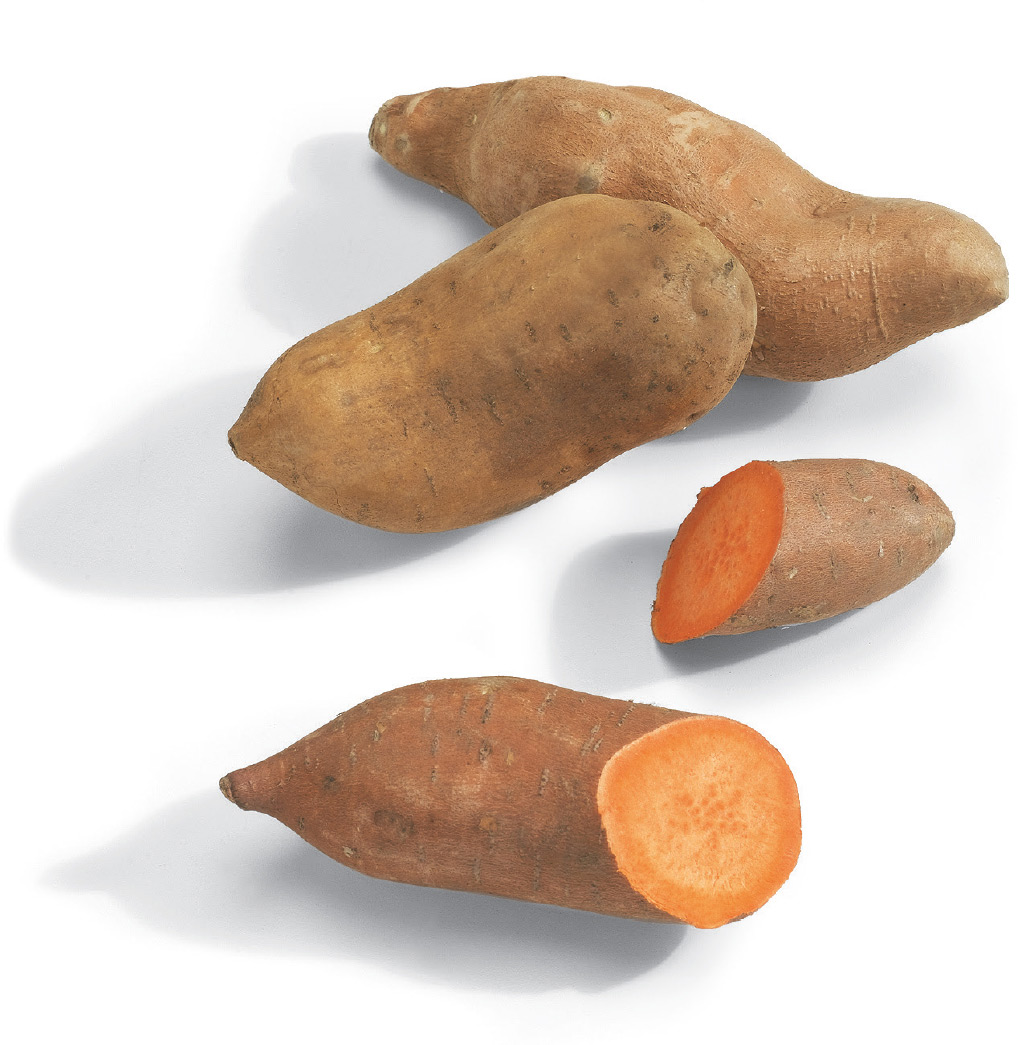
Sweet potatoes are not actually related to the potato—they’re a member of the morning glory family. (Which is a great thing to know if you’re ever on Jeopardy.) They’re sweet, dark, and one of the oldest vegetables known to man, having been around since prehistoric times. And there are many reasons to eat them.
As starchy vegetables go, this is probably my absolute favorite. Back in the days when I spent more hours in the gym than I want to think about, I used to bake a week’s worth of them in advance, wrap them individually, put them in the fridge, and take them with me along with some grilled chicken for an after-workout snack. Something about letting them sit on ice like that for a day makes them sweeter, and they make just about the most delicious snack you can imagine. Note: This is not for people with blood sugar problems (more on that in a moment). For everyone else, it’s light years better than anything in the snack machine, and very portable in the bargain.
This starchy carbohydrate is high in fiber (half of which is soluble) and a rich source of powerful antioxidants in the carotenoid family, especially beta-carotene. Sweet potatoes are loaded with vitamin A and heart-healthy potassium, and they even have a dollop of calcium. An article in the Journal of Agriculture and Food Chemistry found that an extract from a baked sweet potato has chemopreventive (cancer-fighting) properties. Finally, sweet potatoes contain other phytochemicals like quercetin, a powerful anti-inflammatory, and chlorogenic acid, an antioxidant. And a medium-size baked sweet potato has only 103 calories (the operative word there is “medium”).
Potatoes Take a Hit in the Low-Carb Craze
Back in the low-fat 1980s, potatoes were the darling of the fitness set because they are pretty much a fat-free item. Potatoes have since suffered a reversal of fortune, swept out of the diet—along with bread, cereal, and pasta—by a lot of carb-conscious eaters. When consumers began to be (rightly) concerned with controlling their blood sugar, potatoes became vegetable non-grata at the dinner table, because they raise your blood sugar quickly, producing a lot of the fat-storing hormone insulin. That’s why white potatoes didn’t make my list of the healthiest foods. I don’t think they have enough nutritional wallop to counterbalance their effect on blood sugar. By the time a bite of white potato gets to your stomach, the body sees it as just a big lump of sugar. Though they may not be the worst food on the planet, they’re not among the best foods on the planet. (From a health perspective, french-fried potatoes are probably one of the three worst.)
A short course in blood sugar management: The impact of food on blood sugar is of great concern to those trying to lose weight, and of even greater concern for those with either diabetes or metabolic syndrome. The impact of food on blood sugar is most accurately measured by its glycemic load. (The higher the glycemic load, the more it raises blood sugar and the fat-burning hormone, insulin.) Although some people claim that sweet potatoes have a lower glycemic load than regular potatoes, the truth is that only a certain variety from Australia (ipomoea batatas) has anything like what could be called a low glycemic load. (Low glycemic load is technically 10 or under; the Australian variety has 11.) All the rest run between 16 and 20. That is not a bad thing if you aren’t diabetic or prediabetic. But if blood sugar control is an issue for you, either because of stubborn weight problems or medical ones such as diabetes, the glycemic impact of this delicious potato needs to be considered.
So let me be clear: If you don’t have blood sugar issues, sweet potatoes are a great food. And even if you do, eating them in reasonable amounts, as part of a mixed meal with some vegetables and some protein and fat, is hardly the worst thing you could do. And if you’re a bodybuilder at the gym and you’re looking for a great after-workout meal, you can’t do much better than tuna, broccoli, and sweet potatoes.
What’s the Difference between Sweet Potatoes and Yams?
There are two basic types of sweet potato: moist (orange fleshed) and dry (yellow fleshed). Both are delicious. The sweeter orange-fleshed varieties dominate the U.S. market. The moist-fleshed potatoes are often called yams, but this is a misnomer. True yams (botanical family Dioscoreaceae) are large root vegetables grown in Africa and Asia and rarely seen in the Western world.
Whatever you do, don’t forget to eat the skin. It’s the best part and has the most fiber.
 Swiss Chard
Swiss Chard
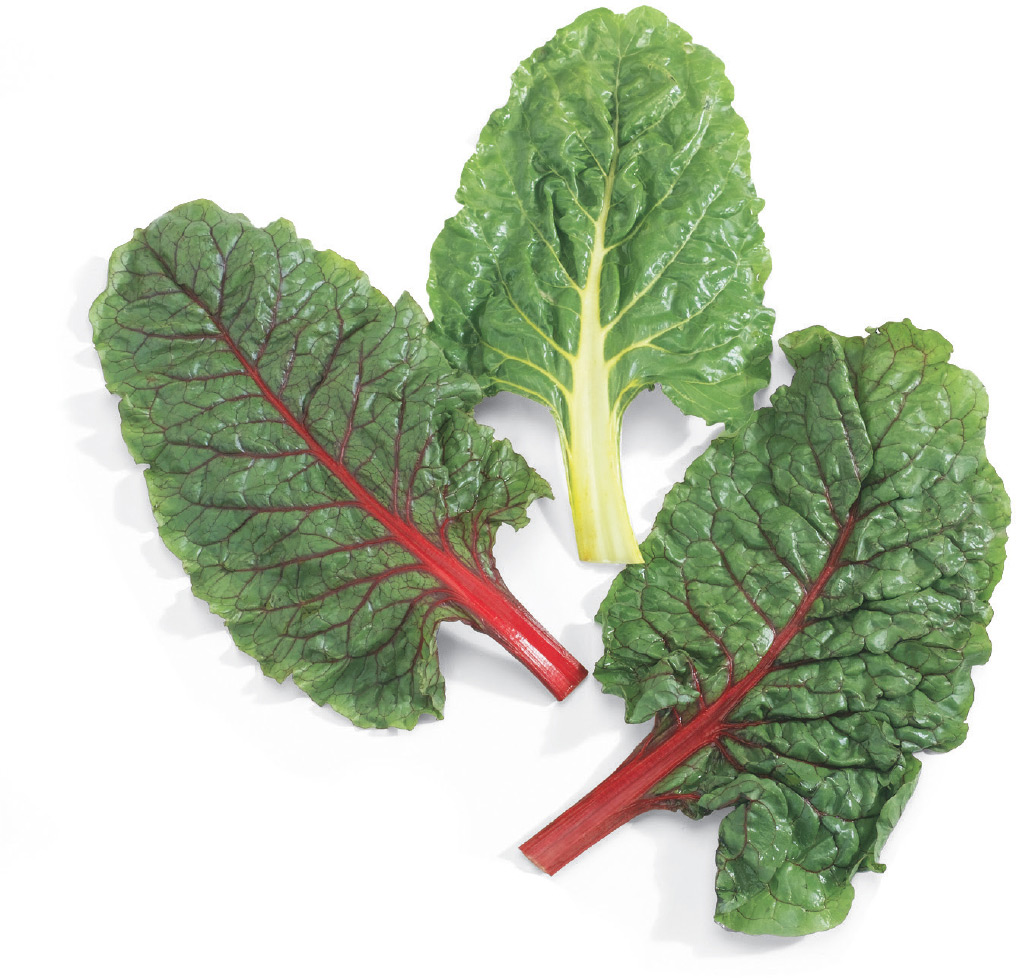
When I first looked up the lab analysis of the nutritional content of Swiss chard, I had to go back and check twice to be sure there wasn’t a mistake. The amount of nutrition in this baby is so spectacular I thought it was a misprint; but no, it’s true. Swiss chard is an excellent example of a nutritional powerhouse that delivers the goods for almost no calories.
Easy on the Eyes
A cup (175 g) of cooked chard gives you almost 4 g of fiber, more than 100 mg of calcium, an incredible 961 mg of potassium, and more than 30 mg of vitamin C. And that’s just the beginning. You also get more than 10,000—that’s right, 10,000—IUs of vitamin A, more than 6,000 of beta-carotene (plus some alpha-carotene as well), and a staggering 19,000 mcg of lutein and zeaxanthin, two members of the carotenoid family that are getting significant research attention for their ability to protect the eyes and guard against vision problems like macular degeneration. And did I mention that one cup—the amount that provides all those nutrients—has 35 calories?
Chard is a member of the goosefoot family of plants, is a relative of beets, and comes in red and white. The red kind is a standout in supermarkets. It’s very quick cooking—like spinach, in fact—so don’t overcook it or you’ll compromise its nutritional value. In her excellent writing on whole food, Rebecca Wood notes that the leaf and stem can be prepared together or may be cooked and served separately as two different vegetables. It’s also perfectly fine raw.
Tomatoes
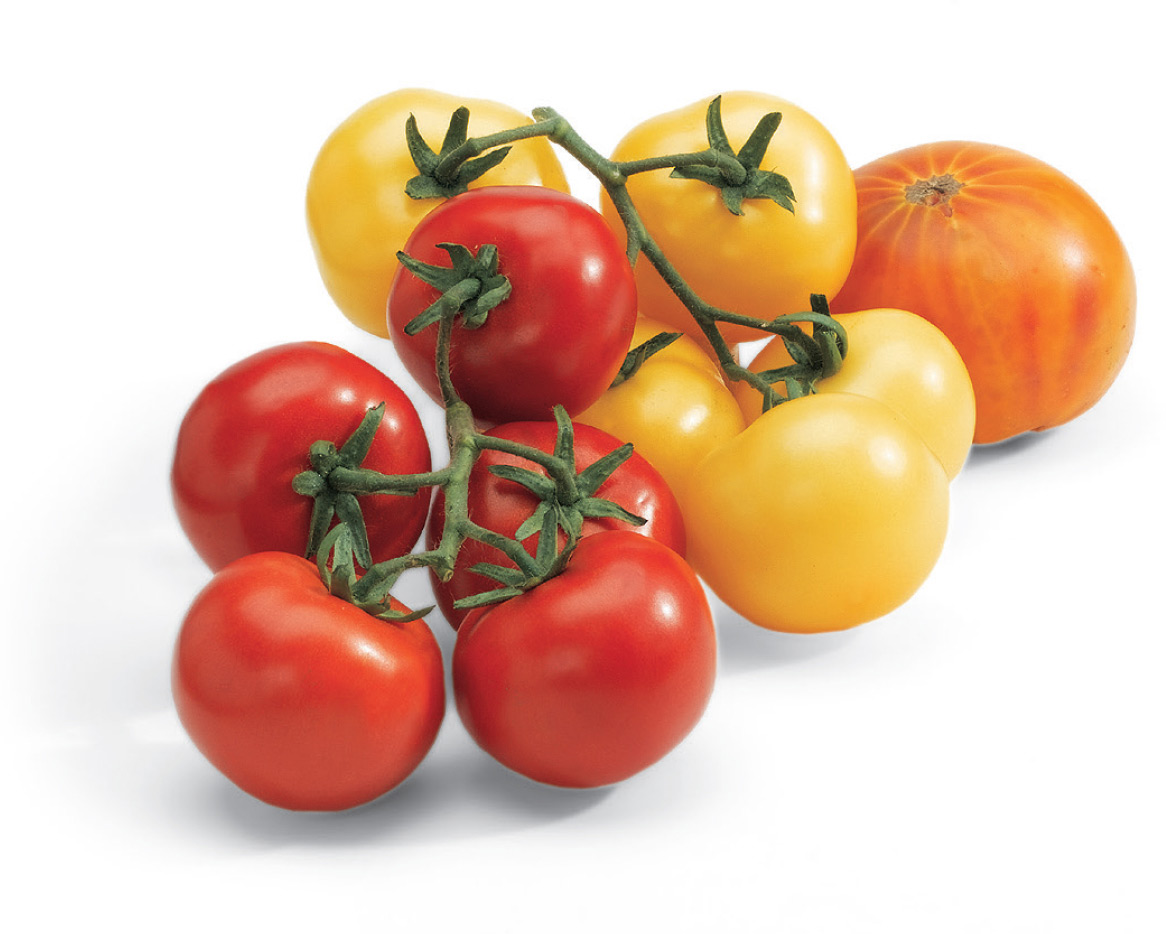
Botanically speaking, tomatoes are a fruit; technically, they’re a berry, and legally, they’re a vegetable. No, I’m not making this up. In an 1893 ruling of the U.S. Supreme Court, the tomato became legally classified as a vegetable because it’s used as one.
Tomato-Eating Men Have Fewer Prostate Cancers
Cooked tomatoes, especially those cooked with oil, are a rich source of the carotenoid lycopene. There is promising research showing that lycopene is associated with significant reduction in prostate cancer. As far back as 1995, the Journal of the National Cancer Institute published the results of a study conducted by Harvard University researchers that looked at the eating habits of more than 47,000 men between the ages of forty and seventy-five. They found that the men eating ten servings or more a week of tomatoes, tomato sauce, tomato juice, and even pizza had 45 percent fewer prostate cancers than men who ate fewer than two servings a week.
In another study done a few years later at the Karmanos Cancer Institute in Detroit, researchers gave lycopene supplements to thirty men who already had prostate cancer. Those given the lycopene supplements had smaller tumors and less spreading of the cancer. Best of all, the tumors in the participants who consumed lycopene supplements showed signs of regression and decreased malignancy.
And it’s not just prostate cancer that the lycopene in tomatoes protects against. Strong evidence indicates that lycopene protects against lung and stomach cancers as well, and preliminary research shows protection against pancreatic, colorectal, esophageal, oral, breast, and cervical cancers. Lycopene also protects the heart against oxidative damage, thereby reducing the risk of heart attacks. And one study published in American Heart Journal showed that treatment with antioxidant-rich tomato extract can reduce blood pressure in patients with grade 1 hypertension.
Get the Most Out of Your Tomatoes
The anticancer properties of lycopene are especially beneficial when consumed with fat-rich foods, such as avocado, olive oil, or nuts. Why? Because carotenoids are fat-soluble nutrients. To get maximum absorption of them, you need to eat them with a little fat!
Besides lycopene, tomatoes contain a variety of other powerful phytochemicals that fight disease. A trio of antioxidants—zera-carotene, phytoene, and phytofluene—are found together in many fruits and vegetables, including tomatoes, and scientists believe that this triple-threat antioxidant team has strong disease-fighting potential. And if that isn’t enough, phenolic acids found in tomatoes have the potential to fight lung cancer with their ability to inhibit the formation of nitrosamines (carcinogenic compounds) in the body.
Tomatoes also have a compound in them called lutein, which is great for your eyes. Lutein is important for eye health—we have lutein in the retina of our eyes and we need it for healthy vision. The lutein in tomatoes may help prevent macular degeneration, a leading cause of blindness in older adults, and may help improve vision. Lutein may also help prevent or slow down the thickening of arteries that we know as atherosclerosis.
Not bad for a fruit—I mean a berry—I mean a vegetable—that up until about 100 years ago was thought to be poisonous!
The Benefits of Vine-Ripened Tomatoes
Tomatoes are an excellent source of vitamin C, though the vitamin C is most concentrated in the jellylike substance that surrounds the seeds. Tomatoes also contain vitamin A, B-complex vitamins, potassium, and phosphorus. Note: A tomato grown in a hothouse has half the vitamin C content as its vine-ripened cousin.
And speaking of vine-ripened: Tomatoes are one of those foods that people rarely appreciate because the commercial kind are picked when green and then artificially ripened with ethylene gas, leaving a food product that may look great, but has negligible taste. You’re best off buying tomatoes from local farmers and getting vine-ripened tomatoes whenever possible. They taste a lot better.
Turnips

Whenever I think of turnips, I can’t help recalling that line in Tennessee Williams’s famous play, Cat on a Hot Tin Roof, where Big Daddy calls the little kids “no-neck monsters”! Sure enough, turnips have no necks, and the fact that they grow just about anywhere, in the poorest soil, has made them kind of like the catfish of vegetables, endearing them to the poor and giving them pretty low status among snobbier folk who haven’t tasted them. But they’re anything but a poor country cousin when it comes to nutrition.
Turnips and rutabagas (see here) are among the most commonly grown and widely adapted root crops. They are members of the Cruciferae family and they both belong to the genus Brassica (cabbage), members of which are widely acclaimed for their cancer-fighting indoles and isothiocyanates and other health-giving phytochemicals. And, along with rutabagas, turnips are particularly high in anticarcinogenic glucosinolates.
Turnip Greens Promote Bone Health
Turnips are another of those high-volume foods that fill you up without costing you a lot of calories. A cup (156 g) of cooked turnips (without the greens) has all of about 35 calories, with 3 g of fiber, more than 250 mg of potassium, 18 mg of vitamin C, and 51 mg of calcium. Add the nutritious bone-building greens to the mix and your calcium nearly triples to 148 mg, plus you get a whopping 14,000 IUs of vitamin A, more than 8,000 IUs of beta-carotene, and an incredible 676 mcg of bone-friendly vitamin K. In the bargain, you also get more than 15,000 mcg of lutein and zeaxanthin, two members of the carotenoid family that have been shown (in a study known as the AREDS-2 Study) to help protect the eyes from vision problems like macular degeneration.
Turnip greens are sometimes available by themselves, usually next to other greens like kale and collards, but sometimes at a farmers’ market you’ll be able to find the turnips with the tops attached. Buy them!
Raw, grated turnips serve as a digestive aid similar to radish and daikon and are good for general detoxification, says natural-foods expert Rebecca Wood.
 Watercress
Watercress
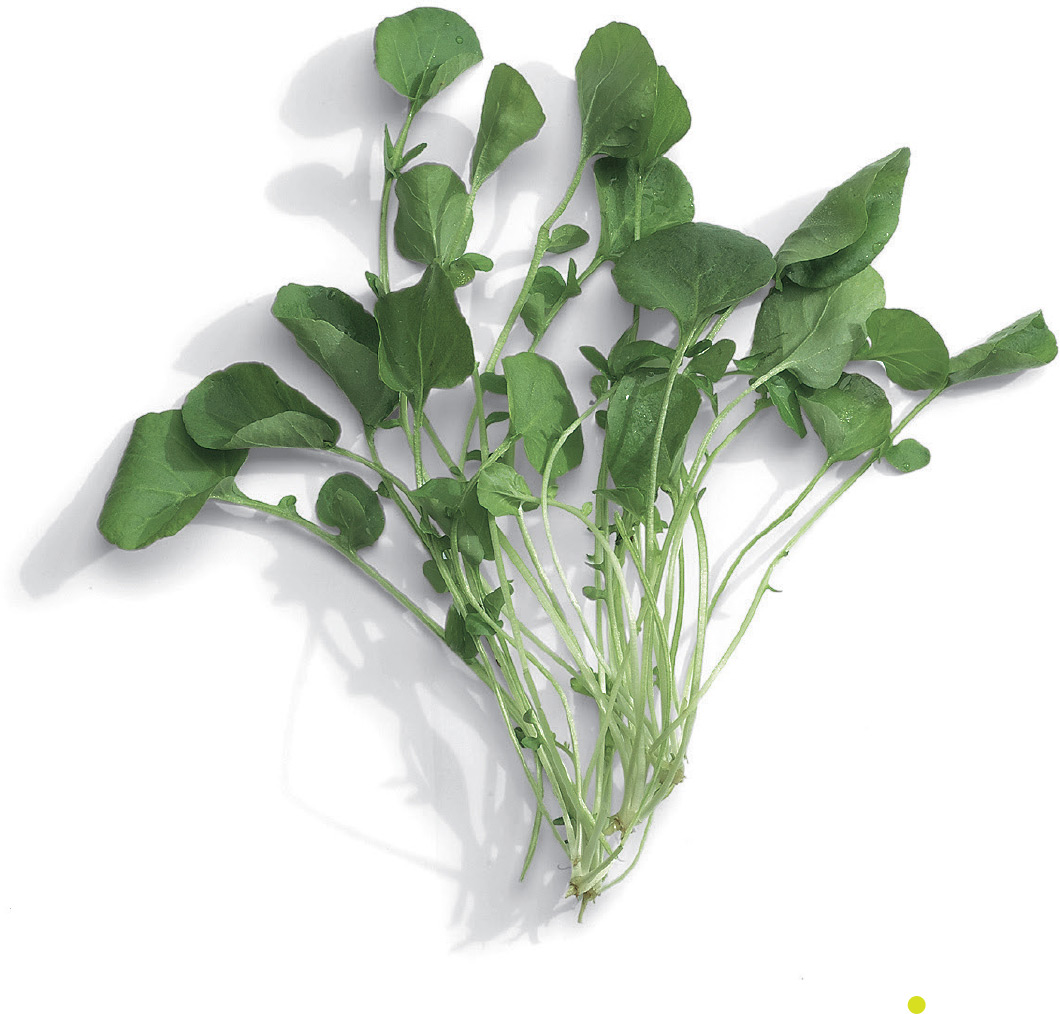
Irish monks used to refer to the watercress plant as “pure food for sages.” And with good reason. This pungent, stimulating herb, frequently found in salads that bear its name, truly deserves the name superfood.
Watercress Contains Four Times the Calcium of Milk
If you were to compare an equal number of calories of watercress with an equal number of calories of 2 percent milk, the watercress would give you four times the calcium and six times the magnesium. Gram for gram, this little plant contains as much vitamin C as oranges and more iron than spinach. It’s also as close to a calorie-free food as you’re likely to find. A full cup (34 g) of the stuff contains only 4 calories, and for those 4 calories you get an amazing 1,500 IUs of immune system–building vitamin A (including 950 mcg as beta-carotene), 85 mcg of bone-building vitamin K, 14 mg of vitamin C, and, as a bonus, more than 1,900 mcg of the new superstars of eye nutrition, lutein and zeaxanthin. Both lutein and zeaxanthin are members of the carotenoid family, and they are being extensively researched for their demonstrated ability to prevent or reduce macular degeneration, the number-one cause of adult blindness.
Watercress Neutralizes Carcinogens
The health benefits of watercress have been known since ancient times. Watercress is a member of the family of vegetable superstars, the Brassica family of cruciferous vegetables, which counts among its members such vegetable royalty as broccoli, cabbage, kale, kohlrabi, and Swiss chard. These vegetables are now known to be excellent sources of a family of anticancer phytochemicals called isothiocyanates. Isothiocyanates literally fight cancer by neutralizing carcinogens—the bad guys of the cancer battle. They do this by reducing their poisonous effects and stimulating the release of “carcinogen killers,” speeding up their removal from the body. Studies have shown that isothiocyanates help prevent lung and esophageal cancer and can lower the risk of other cancers, including gastrointestinal cancer.
Watercress is unique among the cruciferous vegetables in that it contains high concentrations of one particularly potent isothiocyanate, PEITC (phenethyl isothiocyanate). It also contains another group of compounds with anticancer potential belonging to the sulforaphane family (also found in broccoli). Research published in two separate cancer journals—Cancer Research and Carcinogenesis—concluded that the potent combination of PEITC and sulforaphanes had a “triple whammy” effect: zapping cancer cells by inducing their death (apoptosis), stopping potential carcinogens from becoming active, and stimulating cell defenses against assaults from carcinogens.
Watercress can be eaten raw and most frequently is, but it can also be cooked. Natural-foods expert Rebecca Wood says cooking eliminates its bite and leaves a vegetable that is pretty sweet. Remember that when you cook it, its volume is reduced by three-fourths. The raw version probably contains more enzymes and live energy.
Vegetable Runners-Up
Parsnips
The unassuming-looking but amazingly flavorful parsnip has been revered since ancient times, when the first-century Roman emperor Tiberius had them specially imported and served them gently cooked in honeyed wine. A parsnip looks a lot like a carrot that doesn’t get out much—pale and almost white. But there’s a world of difference in the taste.
USE PARSNIPS IN PLACE OF MASHED POTATOES
Parsnips are sweet. Personally, I think they’re a great replacement for white potatoes—they’re nutty and flavorful, and unlike white potatoes, have a lot of nutrition. Plus they lend themselves to mashing really well, making them the ideal substitute for mashed potatoes. Put on a little organic creamy butter, some lemon pepper, and maybe some sea salt, and you’re good to go!
Parsnips are a member of the umbelliferous vegetable group, which the National Cancer Institute has identified as possessing cancer-protective properties. Parsnips have polyacetylenes, plant compounds that help protect against carcinogens. They also contain phthalides, a group of phytochemicals that provide health benefits by stimulating beneficial enzymes and inhibiting inflammatory ones.
(Note: Don’t confuse the beneficial phthalides with the similar sounding phthalates. The two compounds differ in spelling by only two letters, but there’s a world of difference. Phthalates are bad guys. Of all the bad things about fast food, one of the worst is the creation of phthalates from the way the food is prepared. Research from 2015 shows that the phthalates formed in the cooking of fast food increases the risk of cancer.)
Parsnips are high in folate, calcium, potassium, and especially fiber. One little cup (156 g) of cooked parsnips has 51/2 g of fiber, 58 mg of calcium, 45 mg of magnesium, 90 mcg of folate, and a whopping 573 mg of potassium. And it weighs in at slightly more than 100 calories. That’s not insignificant. A cup (156 g) of parsnips has more potassium than a banana.
And let’s not forget the fiber, either. The research on the benefits of fiber continues to explode, and Americans don’t get nearly enough of the stuff because most of our foods have had the fiber processed out of them. Putting parsnips in heavy rotation on your menu helps to correct that deficit.
Here’s a secret lesson about parsnips I learned in my own kitchen—they’re amazing when you juice them. Their nutty flavor adds a lot of richness to a standard apple-carrot-spinach-ginger mix. And, as most cooks know, parsnips are amazing in soups. They have a strong dominating flavor, though, so use with discretion.
Rutabagas
A rutabaga is a strange-looking root vegetable that looks like a cross between a turnip and a wild cabbage. They’re an important part of Scandinavian cuisine and are sometimes referred to as “Swedes.” They can be steamed, boiled, or mashed; baked, roasted, or sautéed; and they’re good in soups. They also make a great puree.
Rutabagas are an amazing source of potassium: One cup (240 g) of the cooked vegetable has 782 mg (about 11/2 times the amount in an extra-large [9-inch or 23 cm] banana!). It also has 115 mg of calcium, 55 mg of magnesium, 45 mg of vitamin C, and a little more than 4 g of fiber. Not too shabby for a mere 94 calories per cup. In Asian medicine, root vegetables are considered “warming” foods that strengthen the digestion and help detoxify the liver.
Here’s a bachelor-friendly dish that’ll make you fall in love with rutabagas: Cut them into cubes, boil them till tender, and toss them with chopped walnuts, raisins, and a little cold-pressed organic honey. You’ll never miss chocolate cake again. Well, okay, I lied, but seriously, that dish will knock your socks off.
Snow Peas
The French name for this tender legume is mange-tout, meaning “eat it all.” Unlike the pod in sugar snap peas, the pod in snow peas tastes as good as the seeds it contains. Almost anyone who has eaten Chinese food has eaten snow peas—they’re flat green pods containing five to seven seeds, and although most Americans know them from Chinese takeout, they’ve been around for centuries—the tender-crisp, jade snow pea was first mentioned in 1597, though pea seeds were found in archaeological digs in Turkey as far back as 5700 B.C.E.
One cup (160 g) of cooked (frozen) snow peas has 5 g of fiber, almost half of the amount most Americans are getting on a daily basis. Remember, that’s way too little—I recommend an absolute minimum of 25 grams a day of fiber, with more being better! They contain lutein and zeaxanthin, two carotenoids that have been shown to be extremely protective of the eyes. They also have 94 mg of calcium and 347 mg of heart-healthy potassium, plus a little vitamin C (35 mg), folate (56 mcg), and a respectable 2,098 IUs of vitamin A, including 1,216 of betacarotene. Snow peas are also a good source of bone-building vitamin K: One cup (160 g) of the cooked peas contains 48 mg. All this for about 80 calories. That’s a nutritional bargain if there ever was one.
Snow peas can be found in the produce section of most health food stores and specialty markets. They’re even beginning to make their way into your general-purpose supermarket, especially in the frozen vegetable section. Look for brightly colored, crisp pods that have fresh-looking leaflets and small seeds. Use as soon as possible or store in the fridge for up to three days.
Note: When you stir-fry them, be sure not to overcook. They taste best—and are most nutritious—when they are bright green. And by the way, they’re very tasty raw, in salads.
THE EXPERTS’ TOP TEN LISTS
Ann Louise Gittleman, Ph.D., C.N.S.
Ann Louise Gittleman is the New York Times’ award-winning author of more than twenty-five books, including The Fat Flush Plan and Before the Change. She was one of the first authors I read when I got interested in nutrition, and she and I now have a mutual admiration society. She has a unique gift for clear explanation and for motivating people, and her fans are legion. She’s appeared on dozens of national television shows, including Dr. Phil and The View.
1. Ground flaxseed: Flaxseeds provide 800 times more cancer-fighting lignans than any other food, which protect against breast and prostate cancer. Delicious in salads, smoothies, and as a topping on veggies.
2. Unsweetened cranberry juice: Rich source of phytonutrients such as phenol-based antioxidants that are so helpful in supporting cardiovascular health and preventing urinary tract infections. Mix in a 1:2 ratio with water!
3. Lemons: High in limonene, lemons are an old-time remedy for thinning the bile and enhancing digestion.
4. Whey: Undenatured, unheated whey protein provides the aminos from which the body makes glutathione, its premier antioxidant.
5. Grass-fed beef: High in the healthy, fat-burning fat CLA (conjugated linoleic acid) plus omega-3s; grass-fed beef is also antibiotic and hormone-free and a great source of zinc and vitamin B12.
6. Spaghetti squash: My personal favorite substitute for pasta, especially for the gluten or carb intolerant. Delicious as spaghetti squash and meatballs!
7. Jicama: Crunchy, juicy, and low calorie, jicama is delightful in salads and as a veggie for dips. Naturally sweet to satisfy the most sophisticated sweet tooth!
8. Peanut butter: Preferably organic, peanut butter is a quick snack that satiates the appetite. High in stress-busting pantothenic acid (vitamin B5).
9. Blueberries: One of the least pesticide-ridden fruits, blueberries are exceptionally high in proanthocyanidins, so helpful in preventing degenerative disease.
10. Organic cream: Organic cream from grass-fed cows is not only a treat but a terrific source of fat-burning CLA! It nourishes the nerves and is a wonderful accompaniment for all sorts of berries.
